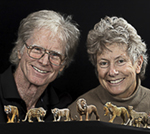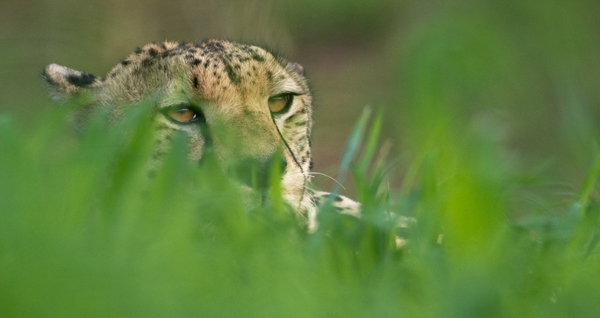
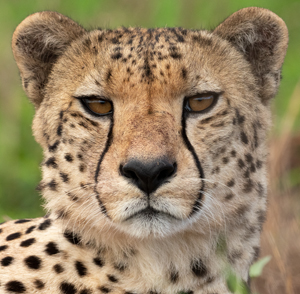
Cheetah - at ground level, on foot
South Africa
November 2019
Scouting Trip Report
.jpg)
African Wild Dogs - a pack of 20
Photos in this report are by both Joe and Mary Ann McDonald
Although we’ve been to South Africa before, for Great White Sharks via a shark cage, this was our first Photo Safari to the region. Our objective, if luck was with us, was African Wild Dogs, although our itinerary would cover virtually all of South Africa’s major game, the Big Five and more. We visited two locations, both private game reserves that provided some very unique shooting opportunities.
The trip began in Johannsburg, reached after a tortuous non-stop flight for most of us from Atlanta, 14 hours in the air. After over-nighting at a small but very nice guest lodge, we flew on to Durban where we met our guide and Steve and Loreleli, who had arrived the previous day. The following morning we continued on by a private transport to our first location, Zimanga, a private game ranch.
Owned by the family of one of the world’s largest sugar cane producers, Zimanga was once cattle ranch land, later stocked with native South African wildlife. Now small herds of Elephant, a small lion pride, and several Cheetah roam a wild landscape. In contrast to a national park, or the larger private reserves bordering Kruger National Park, the Lions and Cheetahs have microchips implanted, which allows the guides to find the cats by radio tracking. The Cheetahs and Wild Dogs (when they were here) could be approached on foot, making for some interesting subject- and ground-level perspectives.
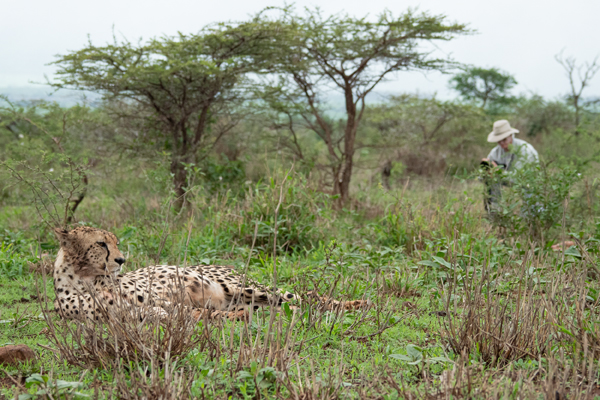
That's me in the background, using the flip-out screen on my Olympus to obtain a low angle without lying flat in the muddy ground. The Cheetah (there were two) had just finished eating a baby Warthog that they had captured earlier.
Zimanga is famous for its ground-level blinds, or hides as they’re known in Africa and Europe, and each day we either did a game drive or spent time in a blind.
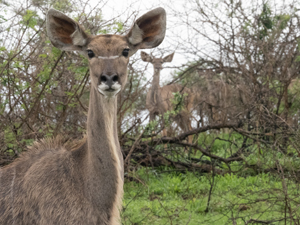 We split into three groups, which stayed together, which was, for us, a departure from our normal protocol of rotating photographers and Mary and I through the three vehicles and mixing up the group. Here at Zimanga, to insure that everyone had a chance at each of the blinds, we had to stay together, but this worked well. Later, when we visited a private reserve in Sabi Sands, we did the same, so that our guide would know what his group had seen, and what they still needed to photograph.
We split into three groups, which stayed together, which was, for us, a departure from our normal protocol of rotating photographers and Mary and I through the three vehicles and mixing up the group. Here at Zimanga, to insure that everyone had a chance at each of the blinds, we had to stay together, but this worked well. Later, when we visited a private reserve in Sabi Sands, we did the same, so that our guide would know what his group had seen, and what they still needed to photograph.
Zimanga offers two unique over-night blinds, where photographers spend the night, watching a waterhole or sleeping. Mary’s group was first in an over-night blind, and everyone’s hope was that we’d have lions, or a serval or leopard, visit for a drink. Photographers entered the blind at 2:30, nearly five hours before darkness, but giving shooters time to photograph whatever came to drink during the late afternoon. A few birds arrived, and at 8PM or so, a lone African Buffalo appeared in the lights, materializing like a black apparition against an even darker night landscape. The Buffalo approached the waterhole, close enough to be fully illuminated by the two LED spotlights positioned on either side, but oddly, the Buffalo never took a drink.
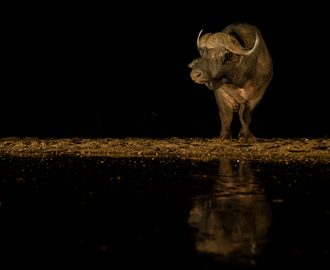

Mary did a RAW conversion into Black and White.
 The rest of the night Mary, John, Jim, and Jack watched moths and termites crash into the pool, frogs calling, toads mating, and giant millipedes creeping across the stones. At dawn, more birds arrived, and at 8AM or so they were retrieved for a return to the lodge, their timing perfect to coincide with a major rainstorm. They reached the lodge soaked.
The rest of the night Mary, John, Jim, and Jack watched moths and termites crash into the pool, frogs calling, toads mating, and giant millipedes creeping across the stones. At dawn, more birds arrived, and at 8AM or so they were retrieved for a return to the lodge, their timing perfect to coincide with a major rainstorm. They reached the lodge soaked.
That night Steve, Loreleli, Jeff, and I tried the blind. We hoped for the best, but throughout much of the day it had been raining, which continued until sunset. Our waterhole was now just one of thousands dotting the land, and aside from a few frogs hopping in, and the resident pond turtles hat coursed the pond like sharks, we saw nothing. At dawn, some Swallows and Weavers arrived, providing some shooting to what was otherwise a long, fruitless evening.
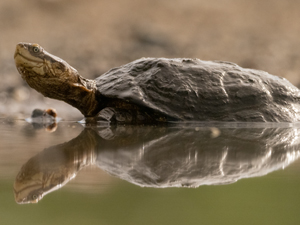
The land was water-logged and the third group, Tom, Debbie, Bill, and our guide, Lisle, passed, as spending the night would be pointless. Fortunately one of the overnight blinds was open the following night, and Tom and Debbie, along with Steve and Loreli (hoping for better luck) took advantage of the chance. A rhino and a buffalo passed, far beyond the lights like shadows, and that was it – although the day had been sunny and hot and most of the puddles had disappeared, the land was still too wet, or the animals not thirsty, and the night was a bust.
 Other blinds were more productive, for some. One morning my group visited the ‘scavenger blind,’ baited with meat to attract vultures, kites, eagles, jackals, and/or hyenas. We had about 18 White-backed Vultures that arrived at 8AM, nearly 2.5 hours after we entered the blind. The ground was soggy with mud, and vultures resembled ducks with their feet so mud-clogged that they appeared to be webbed. In 45 minutes or so all the meat was gone, and the vultures flew off. At one point a very tawny-colored Black-backed Jackal joined the vultures, and we managed several shots.
Other blinds were more productive, for some. One morning my group visited the ‘scavenger blind,’ baited with meat to attract vultures, kites, eagles, jackals, and/or hyenas. We had about 18 White-backed Vultures that arrived at 8AM, nearly 2.5 hours after we entered the blind. The ground was soggy with mud, and vultures resembled ducks with their feet so mud-clogged that they appeared to be webbed. In 45 minutes or so all the meat was gone, and the vultures flew off. At one point a very tawny-colored Black-backed Jackal joined the vultures, and we managed several shots.
On a subsequent day Mary’s group had nothing at the blind, and Tom’s group only had a Spotted Hyena, although the shot Lisle had of the hyena was a great one.
The big hit, for the blinds, was the ‘lagoon blind,’ a water-level blind adjacent to the property’s lake. Everyone rotated through the blind one afternoon, and a few of us paid extra for time in the blind from 10:30AM to 1PM. A variety of birds visited the shoreline or perched on the picturesque limbs placed in the two pools, one on either side of the blind, including Pied and Malachite Kingfishers, Water Thickknees, Striated Herons, Blacksmith Plovers, Painted Snipe, Black Crakes, Hammerkops, Black-winged Stilts, Cormorants, Greenshanks and African Sandpipers, and a lone African Fish Eagle that flew by in the later afternoon sunshine. As with all the blinds, glass separates the photographers from the environment, and occasionally we had to clean the glass when a Pied Kingfisher or a Wagtail splashed water onto the glass. Frame-filling shots of most of the birds was the norm.
.jpg)
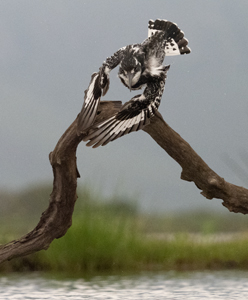
Pied Kingfisher - using ProCapture

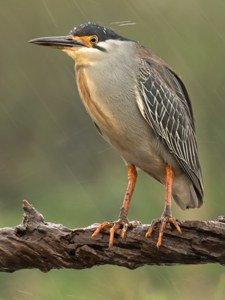
Water Thickknee; Striated Kingfisher

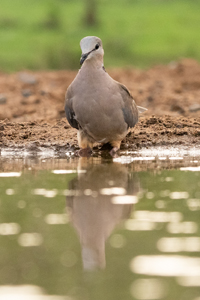
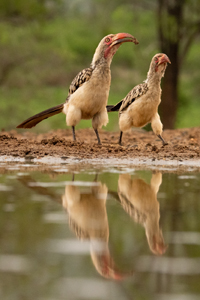
Egyptian Goose; Cape Turtle Dove; Red-billed Hornbills
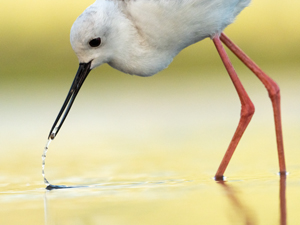
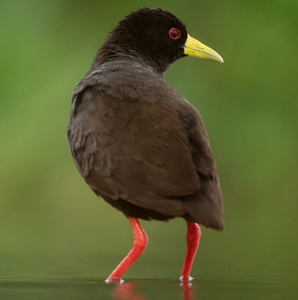
Blackwinged Stilt; Black Crake

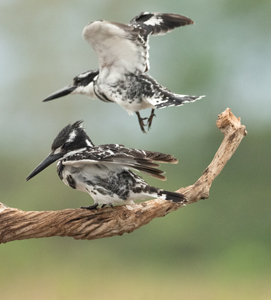
Malachite Kingfisher; Pied Kingfisher
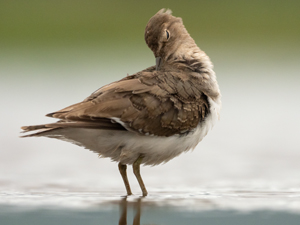
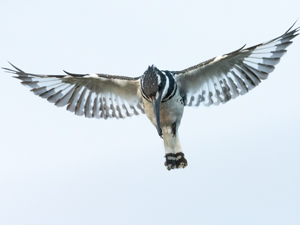
Common Sandpiper; Pied Kingfisher
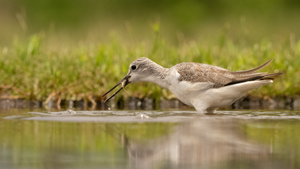

Greenshank; Hammerkop


Egyptian Goose; African Fish Eagle
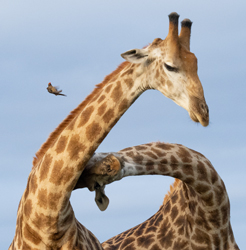
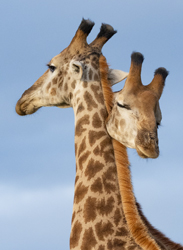

Mary had an incredible session with Southern Giraffes 'necking,' a playful wrestling match where status and dominance can be determined. Tests of strength now may eliminate the need for a serious fight later on as bulls contest the access to females. The force of some blows knocked off the Oxpeckers that were feeding on the giraffes' necks.
On the last morning, opting out of a game drive, Jeff spent time in the last blind, called the Reflection hide. This one is set up for songbirds and with two days without rain we hoped birds would once again visit the blind. They did, and Jeff had a productive morning with a variety of finches and, just before he was collected from the blind, a mother Vervet Monkey and baby.

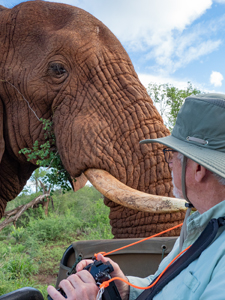
The trunk of this bull elephant was often against the vehicle, about as close as you can get to a wild elephant, but allowing photographers to get some neat close up details.
Our game drives revolved around finding the big cats, rhinos, or Elephants. Everyone had great luck with a pair of African Elephants that often browsed so close that their trunks brushed against the vehicles. One bull was in musth, a time of often hormonal rage that can make a bull Elephant extremely dangerous and aggressive, but this bull, while sometimes disconcertingly curious, never showed aggression. Literally at arm’s length distances, everyone had great opportunities for close-up details of an Elephant’s wrinkled skin, trunk, and expressive eyes.
Using the radio, our groups found a pair of male Cheetahs on almost every attempt. On our first outing everyone had the pair just after they had finished a kill. Here, we can go on foot, and it was a thrill, obviously, to be twenty or thirty feet away from the Cheetahs as they mutually groomed, or stared off as they watched for additional prey.
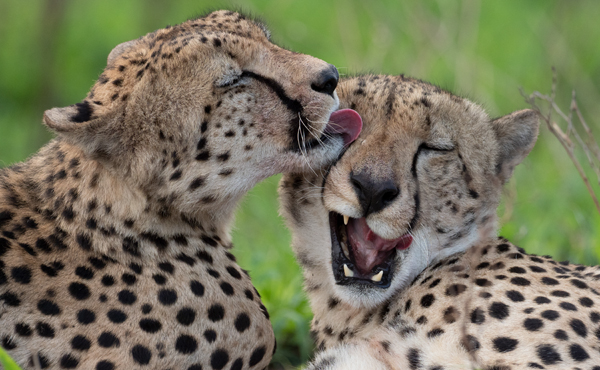
On our last morning, my group searched the far-reaches of the reserve looking for the Cheetahs, finally locating them by radio seconds before they spotted a baby Impala which they quickly caught. We had a brief glimpse of a running cheetah, heading towards one of the border fences where it was sure to corner the Impala, but when we arrived at what we expected to be the site the cats were gone. Lisle spotted them in the distance, the pair carrying the Impala lamb between them. We followed on foot, and that faster amongst us managed some shots of the two cats while they still carried their prey. They consumed it quickly, and for the remainder of the morning we photographed the cats as they groomed each other, removing the stain of blood, before wandering off for some shade as our overcast skies vanished into a hot, bright day.
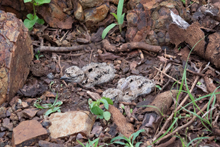 Zimanga had, until relatively recently, a large pack of African Wild Dogs but, disappointingly, the dogs had discovered they could dig out under the fence. After two escapes, the dogs were relocated to another reserve. The pack, a large one of over a dozen, would consume at least two herbivores a day, and were wiping out the Nyala antelope here. Since the reserve was originally restocked with imported game, and the predation by the dogs probably would have outpaced any reproducing on their part. We had looked forward to being on foot with a pack of Wild Dogs, and we hoped we’d have luck at our next destination at Sabi Sands.
Zimanga had, until relatively recently, a large pack of African Wild Dogs but, disappointingly, the dogs had discovered they could dig out under the fence. After two escapes, the dogs were relocated to another reserve. The pack, a large one of over a dozen, would consume at least two herbivores a day, and were wiping out the Nyala antelope here. Since the reserve was originally restocked with imported game, and the predation by the dogs probably would have outpaced any reproducing on their part. We had looked forward to being on foot with a pack of Wild Dogs, and we hoped we’d have luck at our next destination at Sabi Sands.
We encountered two five year old male Lions, both very much in their prime, several times. One group had the Lions in great early morning, angular light, and my group, on our last game drive, had the pair digging at a burrow, either trying to root out a warthog, porcupine, or aardvark. They were not successful as we waited, until on-coming darkness had us heading back to camp.
.jpg)
Leaving Zimanga after an early breakfast, we headed to our next destination at Sabi Sands, one of several private game reserves that lie adjacent to the enormous Kruger National Park. No fence separates a private reserve from the National Park, but the rules are completely different. In Kruger tourists must remain on the road, many of which are paved, while in the private reserves off-road driving is permitted, at least when doing so involves the ‘special animals,’ generally the Big Five.
En route we dropped off our in-country guide, Lisle, who was booked to lead a photography trip in Spain, and we continued on for another two hours towards Kruger and Sabi Sands. Our driver was, frankly, incompetent, and first drove us to the Kruger gate, which was the wrong one! Fortunately the turn he missed was only 15 minutes or so away, back-tracking, but when we arrived at the correct gate we were informed that we needed to pay a vehicle and per person admission fee! Since we had pre-paid our outfitter for a complete package, we were unprepared for this and our guide, who was supposed to have given us that money, wasn’t aware of this and did not. Our driver knew nothing, and after some very annoying confusion, we were able to contact our lodge who arranged with the gate to pay the fees later. At that point, an hour later, we drove on to the lodge.
After a brief orientation at the lodge we were given the option of relaxing, or doing a short game drive in what little remained of the afternoon light. Obviously, we chose a game drive! As we started out, in three vehicles where, once again, we were assigned to for the duration, we were told that ‘a rare sighting’ was available – African Wild Dogs! We headed there.
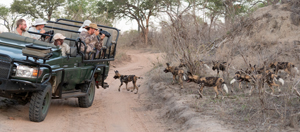 The pack,10 Adults and 10 pups that were now about half the size of the adults, were resting in a river bed. We started shooting just as they awoke for their evening hunt, and those first shots were little more than rather pathetic snapshots, but we still shot, as most of us had never seen dogs, or hadn’t done so in several years. The dogs left the river bed and came to a road, which they either followed or trotted parallel to, sometimes passing right beside our vehicles. I did a shot as Mary expressively displayed her excitement, which all of us shared. It was a
The pack,10 Adults and 10 pups that were now about half the size of the adults, were resting in a river bed. We started shooting just as they awoke for their evening hunt, and those first shots were little more than rather pathetic snapshots, but we still shot, as most of us had never seen dogs, or hadn’t done so in several years. The dogs left the river bed and came to a road, which they either followed or trotted parallel to, sometimes passing right beside our vehicles. I did a shot as Mary expressively displayed her excitement, which all of us shared. It was a 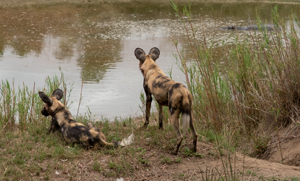 great first game drive!
great first game drive!
The following morning our three vehicles (Mary, Tom and Deb, and Jeff in one; Bill, Jack, Jim and me in another; and Loreli, Steve, and Jack in the third) headed out on game drives. My group encountered Leopards almost immediately – a Leopard female who was being courted by two males. She obviously had a preference, and approached that male frequently, but he growled and snarled and rejected her, and we assume he was more concerned with the presence of the larger male that was always nearby.
In the reserve there is a limit of no more than three vehicles at any animal, and for many only two, and after we had a great sessison we moved on for another vehicle to take our place. Knowing this system, I was a bit concerned that this might prove frustrating, but it did not, and throughout our five days of shooting this rotation and sharing never was an issue.
As we left the Leopards we were told that the Wild Dogs were spotted, and we headed there where we had an incredible shoot, with the dogs having just finished feeding upon two, three, or perhaps even four antelope. We were close once again, and the dogs, particularly the half-grown pups, extremely playful. Our shooting, while frenetic with multiple actions taking place everywhere around us, was more productive than the previous evening, and we stayed with the dogs until they finally settled, flopping down to sleep where they would remain until late afternoon.
That evening my vehicle headed back to find the dogs again, which were exactly where we had left them, still stretched out and asleep. Suddenly they awoke, and for five minutes or so raced about in what is always a pre-hunting, cheer-leading ritual. The dogs then headed off to hunt, and we either followed or got ahead of the dogs, getting wonderful shots as they dogs trotted to and passed us. .jpg) Eventually they went on a chase, and we lost them in the thick brush. On the way back to our lodge we found another Leopard, resting on top of a termite mound but facing away from us. After waiting and watching the light dwindling to darkness, we changed position to have a front view of the Leopard. For some odd reason my LCD monitor, perhaps because of the low light, was providing me with a brighter view than the actual exposure (I was not on Exposure Boost) and I wasn't checking my analog exposure scale - the shot was at 1/13th sec. at ISO 5000. When I checked, I discovered that the shots were over-exposed, but not clipped. Instead, the histograms were just pushed far to the right. While the shots didn't look right, in post-processing all was well, as the shot LEFT shows. Later, the cat shifted position, and the light was too low for an ambient light shot. The image below was shot with a spotlight..
Eventually they went on a chase, and we lost them in the thick brush. On the way back to our lodge we found another Leopard, resting on top of a termite mound but facing away from us. After waiting and watching the light dwindling to darkness, we changed position to have a front view of the Leopard. For some odd reason my LCD monitor, perhaps because of the low light, was providing me with a brighter view than the actual exposure (I was not on Exposure Boost) and I wasn't checking my analog exposure scale - the shot was at 1/13th sec. at ISO 5000. When I checked, I discovered that the shots were over-exposed, but not clipped. Instead, the histograms were just pushed far to the right. While the shots didn't look right, in post-processing all was well, as the shot LEFT shows. Later, the cat shifted position, and the light was too low for an ambient light shot. The image below was shot with a spotlight..

Illuminated by a spot light held high over the leopard's head so that light did not strike directly into the cat's eyes. The spill light still provided enough light
for a 1/50th sec f2.8 ISO 1600 exposure.
The following morning we found them again, and in the course of the morning the dogs played – in the open, and then went on two different hunts where they made kills. In both cases we arrived after the take down, finding the pups clustered tightly around whatever was left. They polished off the kills quickly.
The Wild Dogs were, of course, the highlight, and our most sought-after target. We had Leopards virtually every day, including the mating pair three-some, and a mother Leopard that had killed a Duiker antelope which she hung in a large tree.  While we watched, she left the tree and we thought she was going for her two half-grown, 11 month old cubs. She didn’t, and instead just rested in the shade of a bush. While we waited, her female cub appeared, climbed the tree, and began to feed. We stayed with her until sunset, a spectacular one that the guides considered the afternoon’s highlight.
While we watched, she left the tree and we thought she was going for her two half-grown, 11 month old cubs. She didn’t, and instead just rested in the shade of a bush. While we waited, her female cub appeared, climbed the tree, and began to feed. We stayed with her until sunset, a spectacular one that the guides considered the afternoon’s highlight.
Our group encountered great Black Rhino, a mother White Rhino and calf, African Buffalo, Hyena, and various antelope on our different drives. One afternoon my vehicle photographed two Lionesses with a cub, while our two other vehicles found a larger pride where, in a light drizzle, they played and pounced and wrestled one another in a spectacular show.
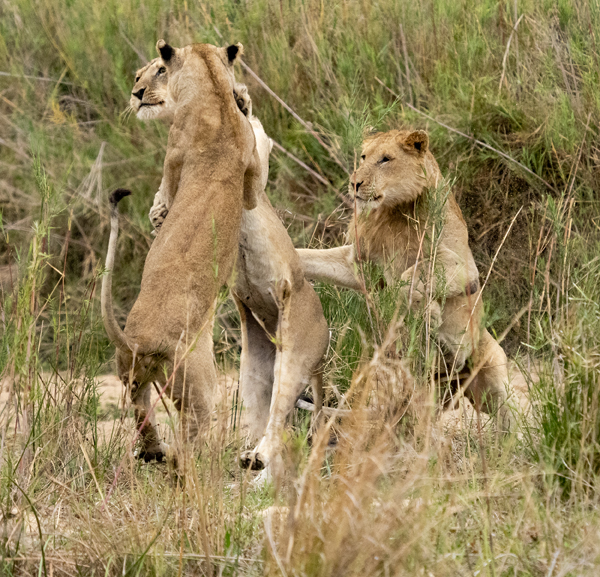
Mary's vehicle had a pride of playful lions, repeatedly leaping in the air to wrestle.
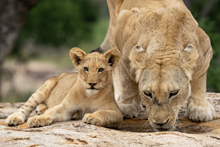
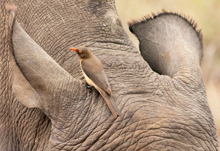
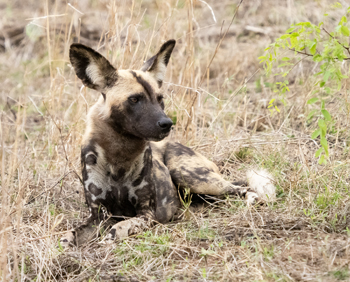
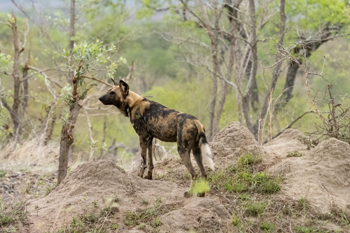




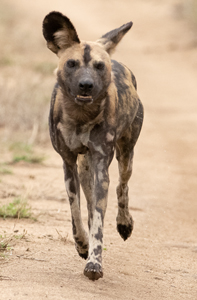
Wild Dogs are amazingly bold, and the entire pack of 20 dogs would trot straight to our vehicle. Sometimes I'd hang out the side of the vehicle and use the Olympus flip-out LCD monitor to get a lower angle, and dogs practically sniffed the lens at times.
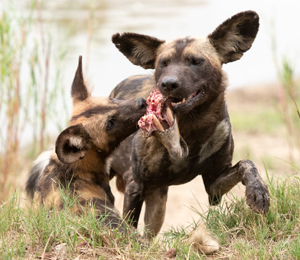
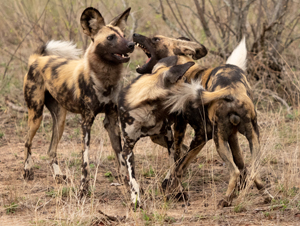
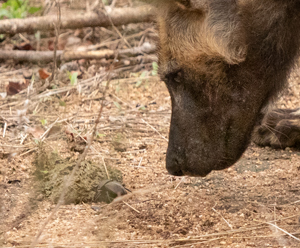
Prey was consumed quickly, and usually, by the time we arrived at the site of a kill the adults were finished, although they left much of the carcass for the 10 half-grown pups to consume. When not eating, the pups and adults often played, wrestling and play-fighting, or (bottom shot) inspecting Dung Beetles that were nearby.

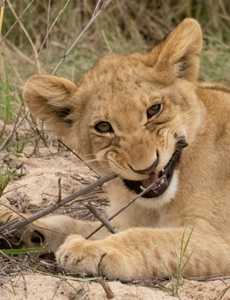
Bushbuck; Lion cub
I could not have made the Bushbuck shot with my old Canon gear. I had to shoot around the driver/guide, so I extended my arm through the bars behind his set, and at arm's length I framed the shot, using the LCD monitor and positioning the sensor over the buck's face.
The light weight of the rig - Mark II and 40-150mm -- made this possible. With a heavier camera this would have been impossible for me.
On our last full day it rained during the early morning game drive, a drizzle that seemed to suppress most subjects although Mary’s vehicle had a male Leopard drinking from a roadside pond. My vehicle had several good birds, and, towards the end of the drive, the skies cleared, almost magically.
Our last evening game drive was special. The rain clouds had vanished and a cool breeze made the drive pleasant. Termites, triggered by the rain, were flying everywhere, and White-crowned Shrikes and Gray Go-away Birds fed along the game tracks. We spotted a Leopard, a large female that prompted discussion as to its sex, and we watched her for a half hour or so, hoping she would begin a hunt.
The Wild Dogs were spotted and we headed there, finding the dogs while there was still plenty of light and, surprisingly, more heat than I’d expect for activity that early. As usual, we followed along until they began a hunt, which we paralleled as the dogs ran across an open field, backlighted by the late afternoon sun. I tried shooting as we drove, and managed one framed and in-focus shot as we raced along. The dogs disappeared, but another vehicle found them as they made a kill and we headed in that direction.
.jpg)
Using my Olympus 40-150 at 150mm (300mm equivalent) I shot this dog as it began its hunt. No big deal, except we were driving along side, about 25mph, on a bumpy game track. Getting a sensor on the dog was the challenge -- the AF of the Mark II camera did the rest. I was really impressed.
The dogs had killed two Impala, both perhaps adults, with the pups eating on one side of the game track and the adults, with a large adult Impala, on the other. At one point an adult carried the remains of the smaller carcass towards the road, and while I tried to shoot I was set for video and the camera didn’t fire. By the time I corrected the error the Dog had dropped the kill, and the pups were swarming over it in a mob.
Meanwhile, at the larger kill, a lone Spotted Hyena arrived and attempted to steal the kill. The dogs mobbed the Hyena, which was backed into long grass, hindquarters down for protection from the dogs’ bites. Once, a dog squealed, and the entire pack swarmed in defensively. The Hyena tried to steal the kill several times, creeping in submissively on its belly, before it began to whoop, calling in reenforcements. A few seconds later we heard answering whoops, and within a minute four or five Hyenas rushed in, including a huge female, the clan leader, who drove off the dogs without any further argument.
In 18 years of tracking, our tracker had never seen anything like this, nor did our lodge guide. The light was low and, wisely, I did video as the action simply couldn’t be captured with a photograph. It was an incredible ending for our last full day of game driving in South Africa, and surely one of the highlights for the trip.
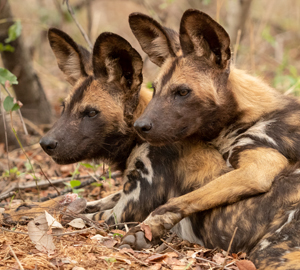

Wild Dog pups, Nyala antelope
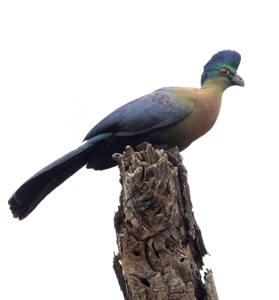
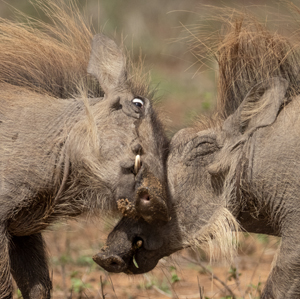
Purple-crested Turaco or Lourie; Warthog
On our last day we had a final AM game drive, a relaxing drive that included more Leopard and Lion sightings. In all, we had Leopards on almost every game drive, and African Wild Dogs on four of our five days. To me, one of the most amazing aspect of Sabi Sands was the relaxed, nonchalant attitude the big cats had towards vehicles. For the specialty animals, like Rhinos, Leopards, Wild Dogs, and Lions, vehicles can drive off track, sometimes driving over two-inch thick saplings or brush that sprang back after our vehicle passed. Often, we’d drive over dry logs or limbs that cracked like fire crackers as our tires snapped the branches, yet the animals never looked our way. In contrast, in East Africa, disturbances like this would likely result in the animal getting up and moving off. I think the fact that the drivers are very respectful of the animals, and only two, or a maximum of three, vehicles are ever around any animal, results in an uncrowded and unstressed environment for the target species. Still, it was amazing to observe, and very wonderful, too.
We’ll be returning to South Africa and the sites discussed in this Trip Report in 2021, and this trip is now a permanent part of our tour itineraries. Join us … the shooting in incredible!

Prior to a hunt the dogs play, working up energy and enthusiasm, reminding me
of cheer leading to get the team going.

After making a kill and satisfying their immediate hunger the Wild Dogs play,
chasing one another as dogs snatch a leg or other body part from the kill.
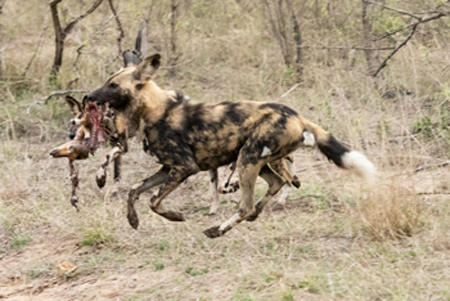
We will be doing our first official Photo Tour to South Africa in 2021,
incorporating the locations cited above, but with important changes as we've fine-tuned this incredible trip. Come join us! The wildlife is unique!
Why you should travel with us
Testimonials
Check out the prices -
Olympus Official Store
Featured on ShotKit - read the interview
Join us on Facebook at: Follow Hoot Hollow
Office Phone: (717) 543-6423
Or FAX us at: (717) 543-5342
Mary and Joe are proud to endorse the Photo Retailer that has
done the absolute most in supporting nature photography in all
its facets ---

Check out the Monthly Specials
from Hunt's


Cheetah - at ground level, on foot
South Africa
November 2019
Scouting Trip Report
.jpg)
African Wild Dogs - a pack of 20
Photos in this report are by both Joe and Mary Ann McDonald
Although we’ve been to South Africa before, for Great White Sharks via a shark cage, this was our first Photo Safari to the region. Our objective, if luck was with us, was African Wild Dogs, although our itinerary would cover virtually all of South Africa’s major game, the Big Five and more. We visited two locations, both private game reserves that provided some very unique shooting opportunities.
The trip began in Johannsburg, reached after a tortuous non-stop flight for most of us from Atlanta, 14 hours in the air. After over-nighting at a small but very nice guest lodge, we flew on to Durban where we met our guide and Steve and Loreleli, who had arrived the previous day. The following morning we continued on by a private transport to our first location, Zimanga, a private game ranch.
Owned by the family of one of the world’s largest sugar cane producers, Zimanga was once cattle ranch land, later stocked with native South African wildlife. Now small herds of Elephant, a small lion pride, and several Cheetah roam a wild landscape. In contrast to a national park, or the larger private reserves bordering Kruger National Park, the Lions and Cheetahs have microchips implanted, which allows the guides to find the cats by radio tracking. The Cheetahs and Wild Dogs (when they were here) could be approached on foot, making for some interesting subject- and ground-level perspectives.

That's me in the background, using the flip-out screen on my Olympus to obtain a low angle without lying flat in the muddy ground. The Cheetah (there were two) had just finished eating a baby Warthog that they had captured earlier.
Zimanga is famous for its ground-level blinds, or hides as they’re known in Africa and Europe, and each day we either did a game drive or spent time in a blind.
 We split into three groups, which stayed together, which was, for us, a departure from our normal protocol of rotating photographers and Mary and I through the three vehicles and mixing up the group. Here at Zimanga, to insure that everyone had a chance at each of the blinds, we had to stay together, but this worked well. Later, when we visited a private reserve in Sabi Sands, we did the same, so that our guide would know what his group had seen, and what they still needed to photograph.
We split into three groups, which stayed together, which was, for us, a departure from our normal protocol of rotating photographers and Mary and I through the three vehicles and mixing up the group. Here at Zimanga, to insure that everyone had a chance at each of the blinds, we had to stay together, but this worked well. Later, when we visited a private reserve in Sabi Sands, we did the same, so that our guide would know what his group had seen, and what they still needed to photograph.
Zimanga offers two unique over-night blinds, where photographers spend the night, watching a waterhole or sleeping. Mary’s group was first in an over-night blind, and everyone’s hope was that we’d have lions, or a serval or leopard, visit for a drink. Photographers entered the blind at 2:30, nearly five hours before darkness, but giving shooters time to photograph whatever came to drink during the late afternoon. A few birds arrived, and at 8PM or so, a lone African Buffalo appeared in the lights, materializing like a black apparition against an even darker night landscape. The Buffalo approached the waterhole, close enough to be fully illuminated by the two LED spotlights positioned on either side, but oddly, the Buffalo never took a drink.


Mary did a RAW conversion into Black and White.
 The rest of the night Mary, John, Jim, and Jack watched moths and termites crash into the pool, frogs calling, toads mating, and giant millipedes creeping across the stones. At dawn, more birds arrived, and at 8AM or so they were retrieved for a return to the lodge, their timing perfect to coincide with a major rainstorm. They reached the lodge soaked.
The rest of the night Mary, John, Jim, and Jack watched moths and termites crash into the pool, frogs calling, toads mating, and giant millipedes creeping across the stones. At dawn, more birds arrived, and at 8AM or so they were retrieved for a return to the lodge, their timing perfect to coincide with a major rainstorm. They reached the lodge soaked.
That night Steve, Loreleli, Jeff, and I tried the blind. We hoped for the best, but throughout much of the day it had been raining, which continued until sunset. Our waterhole was now just one of thousands dotting the land, and aside from a few frogs hopping in, and the resident pond turtles hat coursed the pond like sharks, we saw nothing. At dawn, some Swallows and Weavers arrived, providing some shooting to what was otherwise a long, fruitless evening.

The land was water-logged and the third group, Tom, Debbie, Bill, and our guide, Lisle, passed, as spending the night would be pointless. Fortunately one of the overnight blinds was open the following night, and Tom and Debbie, along with Steve and Loreli (hoping for better luck) took advantage of the chance. A rhino and a buffalo passed, far beyond the lights like shadows, and that was it – although the day had been sunny and hot and most of the puddles had disappeared, the land was still too wet, or the animals not thirsty, and the night was a bust.
 Other blinds were more productive, for some. One morning my group visited the ‘scavenger blind,’ baited with meat to attract vultures, kites, eagles, jackals, and/or hyenas. We had about 18 White-backed Vultures that arrived at 8AM, nearly 2.5 hours after we entered the blind. The ground was soggy with mud, and vultures resembled ducks with their feet so mud-clogged that they appeared to be webbed. In 45 minutes or so all the meat was gone, and the vultures flew off. At one point a very tawny-colored Black-backed Jackal joined the vultures, and we managed several shots.
Other blinds were more productive, for some. One morning my group visited the ‘scavenger blind,’ baited with meat to attract vultures, kites, eagles, jackals, and/or hyenas. We had about 18 White-backed Vultures that arrived at 8AM, nearly 2.5 hours after we entered the blind. The ground was soggy with mud, and vultures resembled ducks with their feet so mud-clogged that they appeared to be webbed. In 45 minutes or so all the meat was gone, and the vultures flew off. At one point a very tawny-colored Black-backed Jackal joined the vultures, and we managed several shots.
On a subsequent day Mary’s group had nothing at the blind, and Tom’s group only had a Spotted Hyena, although the shot Lisle had of the hyena was a great one.
The big hit, for the blinds, was the ‘lagoon blind,’ a water-level blind adjacent to the property’s lake. Everyone rotated through the blind one afternoon, and a few of us paid extra for time in the blind from 10:30AM to 1PM. A variety of birds visited the shoreline or perched on the picturesque limbs placed in the two pools, one on either side of the blind, including Pied and Malachite Kingfishers, Water Thickknees, Striated Herons, Blacksmith Plovers, Painted Snipe, Black Crakes, Hammerkops, Black-winged Stilts, Cormorants, Greenshanks and African Sandpipers, and a lone African Fish Eagle that flew by in the later afternoon sunshine. As with all the blinds, glass separates the photographers from the environment, and occasionally we had to clean the glass when a Pied Kingfisher or a Wagtail splashed water onto the glass. Frame-filling shots of most of the birds was the norm.
.jpg)

Pied Kingfisher - using ProCapture


Water Thickknee; Striated Kingfisher



Egyptian Goose; Cape Turtle Dove; Red-billed Hornbills


Blackwinged Stilt; Black Crake


Malachite Kingfisher; Pied Kingfisher


Common Sandpiper; Pied Kingfisher


Greenshank; Hammerkop


Egyptian Goose; African Fish Eagle



Mary had an incredible session with Southern Giraffes 'necking,' a playful wrestling match where status and dominance can be determined. Tests of strength now may eliminate the need for a serious fight later on as bulls contest the access to females. The force of some blows knocked off the Oxpeckers that were feeding on the giraffes' necks.
On the last morning, opting out of a game drive, Jeff spent time in the last blind, called the Reflection hide. This one is set up for songbirds and with two days without rain we hoped birds would once again visit the blind. They did, and Jeff had a productive morning with a variety of finches and, just before he was collected from the blind, a mother Vervet Monkey and baby.


The trunk of this bull elephant was often against the vehicle, about as close as you can get to a wild elephant, but allowing photographers to get some neat close up details.
Our game drives revolved around finding the big cats, rhinos, or Elephants. Everyone had great luck with a pair of African Elephants that often browsed so close that their trunks brushed against the vehicles. One bull was in musth, a time of often hormonal rage that can make a bull Elephant extremely dangerous and aggressive, but this bull, while sometimes disconcertingly curious, never showed aggression. Literally at arm’s length distances, everyone had great opportunities for close-up details of an Elephant’s wrinkled skin, trunk, and expressive eyes.
Using the radio, our groups found a pair of male Cheetahs on almost every attempt. On our first outing everyone had the pair just after they had finished a kill. Here, we can go on foot, and it was a thrill, obviously, to be twenty or thirty feet away from the Cheetahs as they mutually groomed, or stared off as they watched for additional prey.

On our last morning, my group searched the far-reaches of the reserve looking for the Cheetahs, finally locating them by radio seconds before they spotted a baby Impala which they quickly caught. We had a brief glimpse of a running cheetah, heading towards one of the border fences where it was sure to corner the Impala, but when we arrived at what we expected to be the site the cats were gone. Lisle spotted them in the distance, the pair carrying the Impala lamb between them. We followed on foot, and that faster amongst us managed some shots of the two cats while they still carried their prey. They consumed it quickly, and for the remainder of the morning we photographed the cats as they groomed each other, removing the stain of blood, before wandering off for some shade as our overcast skies vanished into a hot, bright day.
 Zimanga had, until relatively recently, a large pack of African Wild Dogs but, disappointingly, the dogs had discovered they could dig out under the fence. After two escapes, the dogs were relocated to another reserve. The pack, a large one of over a dozen, would consume at least two herbivores a day, and were wiping out the Nyala antelope here. Since the reserve was originally restocked with imported game, and the predation by the dogs probably would have outpaced any reproducing on their part. We had looked forward to being on foot with a pack of Wild Dogs, and we hoped we’d have luck at our next destination at Sabi Sands.
Zimanga had, until relatively recently, a large pack of African Wild Dogs but, disappointingly, the dogs had discovered they could dig out under the fence. After two escapes, the dogs were relocated to another reserve. The pack, a large one of over a dozen, would consume at least two herbivores a day, and were wiping out the Nyala antelope here. Since the reserve was originally restocked with imported game, and the predation by the dogs probably would have outpaced any reproducing on their part. We had looked forward to being on foot with a pack of Wild Dogs, and we hoped we’d have luck at our next destination at Sabi Sands.
We encountered two five year old male Lions, both very much in their prime, several times. One group had the Lions in great early morning, angular light, and my group, on our last game drive, had the pair digging at a burrow, either trying to root out a warthog, porcupine, or aardvark. They were not successful as we waited, until on-coming darkness had us heading back to camp.
.jpg)
Leaving Zimanga after an early breakfast, we headed to our next destination at Sabi Sands, one of several private game reserves that lie adjacent to the enormous Kruger National Park. No fence separates a private reserve from the National Park, but the rules are completely different. In Kruger tourists must remain on the road, many of which are paved, while in the private reserves off-road driving is permitted, at least when doing so involves the ‘special animals,’ generally the Big Five.
En route we dropped off our in-country guide, Lisle, who was booked to lead a photography trip in Spain, and we continued on for another two hours towards Kruger and Sabi Sands. Our driver was, frankly, incompetent, and first drove us to the Kruger gate, which was the wrong one! Fortunately the turn he missed was only 15 minutes or so away, back-tracking, but when we arrived at the correct gate we were informed that we needed to pay a vehicle and per person admission fee! Since we had pre-paid our outfitter for a complete package, we were unprepared for this and our guide, who was supposed to have given us that money, wasn’t aware of this and did not. Our driver knew nothing, and after some very annoying confusion, we were able to contact our lodge who arranged with the gate to pay the fees later. At that point, an hour later, we drove on to the lodge.
After a brief orientation at the lodge we were given the option of relaxing, or doing a short game drive in what little remained of the afternoon light. Obviously, we chose a game drive! As we started out, in three vehicles where, once again, we were assigned to for the duration, we were told that ‘a rare sighting’ was available – African Wild Dogs! We headed there.
 The pack,10 Adults and 10 pups that were now about half the size of the adults, were resting in a river bed. We started shooting just as they awoke for their evening hunt, and those first shots were little more than rather pathetic snapshots, but we still shot, as most of us had never seen dogs, or hadn’t done so in several years. The dogs left the river bed and came to a road, which they either followed or trotted parallel to, sometimes passing right beside our vehicles. I did a shot as Mary expressively displayed her excitement, which all of us shared. It was a
The pack,10 Adults and 10 pups that were now about half the size of the adults, were resting in a river bed. We started shooting just as they awoke for their evening hunt, and those first shots were little more than rather pathetic snapshots, but we still shot, as most of us had never seen dogs, or hadn’t done so in several years. The dogs left the river bed and came to a road, which they either followed or trotted parallel to, sometimes passing right beside our vehicles. I did a shot as Mary expressively displayed her excitement, which all of us shared. It was a  great first game drive!
great first game drive!
The following morning our three vehicles (Mary, Tom and Deb, and Jeff in one; Bill, Jack, Jim and me in another; and Loreli, Steve, and Jack in the third) headed out on game drives. My group encountered Leopards almost immediately – a Leopard female who was being courted by two males. She obviously had a preference, and approached that male frequently, but he growled and snarled and rejected her, and we assume he was more concerned with the presence of the larger male that was always nearby.
In the reserve there is a limit of no more than three vehicles at any animal, and for many only two, and after we had a great sessison we moved on for another vehicle to take our place. Knowing this system, I was a bit concerned that this might prove frustrating, but it did not, and throughout our five days of shooting this rotation and sharing never was an issue.
As we left the Leopards we were told that the Wild Dogs were spotted, and we headed there where we had an incredible shoot, with the dogs having just finished feeding upon two, three, or perhaps even four antelope. We were close once again, and the dogs, particularly the half-grown pups, extremely playful. Our shooting, while frenetic with multiple actions taking place everywhere around us, was more productive than the previous evening, and we stayed with the dogs until they finally settled, flopping down to sleep where they would remain until late afternoon.
That evening my vehicle headed back to find the dogs again, which were exactly where we had left them, still stretched out and asleep. Suddenly they awoke, and for five minutes or so raced about in what is always a pre-hunting, cheer-leading ritual. The dogs then headed off to hunt, and we either followed or got ahead of the dogs, getting wonderful shots as they dogs trotted to and passed us. .jpg) Eventually they went on a chase, and we lost them in the thick brush. On the way back to our lodge we found another Leopard, resting on top of a termite mound but facing away from us. After waiting and watching the light dwindling to darkness, we changed position to have a front view of the Leopard. For some odd reason my LCD monitor, perhaps because of the low light, was providing me with a brighter view than the actual exposure (I was not on Exposure Boost) and I wasn't checking my analog exposure scale - the shot was at 1/13th sec. at ISO 5000. When I checked, I discovered that the shots were over-exposed, but not clipped. Instead, the histograms were just pushed far to the right. While the shots didn't look right, in post-processing all was well, as the shot LEFT shows. Later, the cat shifted position, and the light was too low for an ambient light shot. The image below was shot with a spotlight..
Eventually they went on a chase, and we lost them in the thick brush. On the way back to our lodge we found another Leopard, resting on top of a termite mound but facing away from us. After waiting and watching the light dwindling to darkness, we changed position to have a front view of the Leopard. For some odd reason my LCD monitor, perhaps because of the low light, was providing me with a brighter view than the actual exposure (I was not on Exposure Boost) and I wasn't checking my analog exposure scale - the shot was at 1/13th sec. at ISO 5000. When I checked, I discovered that the shots were over-exposed, but not clipped. Instead, the histograms were just pushed far to the right. While the shots didn't look right, in post-processing all was well, as the shot LEFT shows. Later, the cat shifted position, and the light was too low for an ambient light shot. The image below was shot with a spotlight..

Illuminated by a spot light held high over the leopard's head so that light did not strike directly into the cat's eyes. The spill light still provided enough light
for a 1/50th sec f2.8 ISO 1600 exposure.
The following morning we found them again, and in the course of the morning the dogs played – in the open, and then went on two different hunts where they made kills. In both cases we arrived after the take down, finding the pups clustered tightly around whatever was left. They polished off the kills quickly.
The Wild Dogs were, of course, the highlight, and our most sought-after target. We had Leopards virtually every day, including the mating pair three-some, and a mother Leopard that had killed a Duiker antelope which she hung in a large tree.  While we watched, she left the tree and we thought she was going for her two half-grown, 11 month old cubs. She didn’t, and instead just rested in the shade of a bush. While we waited, her female cub appeared, climbed the tree, and began to feed. We stayed with her until sunset, a spectacular one that the guides considered the afternoon’s highlight.
While we watched, she left the tree and we thought she was going for her two half-grown, 11 month old cubs. She didn’t, and instead just rested in the shade of a bush. While we waited, her female cub appeared, climbed the tree, and began to feed. We stayed with her until sunset, a spectacular one that the guides considered the afternoon’s highlight.
Our group encountered great Black Rhino, a mother White Rhino and calf, African Buffalo, Hyena, and various antelope on our different drives. One afternoon my vehicle photographed two Lionesses with a cub, while our two other vehicles found a larger pride where, in a light drizzle, they played and pounced and wrestled one another in a spectacular show.

Mary's vehicle had a pride of playful lions, repeatedly leaping in the air to wrestle.









Wild Dogs are amazingly bold, and the entire pack of 20 dogs would trot straight to our vehicle. Sometimes I'd hang out the side of the vehicle and use the Olympus flip-out LCD monitor to get a lower angle, and dogs practically sniffed the lens at times.



Prey was consumed quickly, and usually, by the time we arrived at the site of a kill the adults were finished, although they left much of the carcass for the 10 half-grown pups to consume. When not eating, the pups and adults often played, wrestling and play-fighting, or (bottom shot) inspecting Dung Beetles that were nearby.


Bushbuck; Lion cub
I could not have made the Bushbuck shot with my old Canon gear. I had to shoot around the driver/guide, so I extended my arm through the bars behind his set, and at arm's length I framed the shot, using the LCD monitor and positioning the sensor over the buck's face.
The light weight of the rig - Mark II and 40-150mm -- made this possible. With a heavier camera this would have been impossible for me.
On our last full day it rained during the early morning game drive, a drizzle that seemed to suppress most subjects although Mary’s vehicle had a male Leopard drinking from a roadside pond. My vehicle had several good birds, and, towards the end of the drive, the skies cleared, almost magically.
Our last evening game drive was special. The rain clouds had vanished and a cool breeze made the drive pleasant. Termites, triggered by the rain, were flying everywhere, and White-crowned Shrikes and Gray Go-away Birds fed along the game tracks. We spotted a Leopard, a large female that prompted discussion as to its sex, and we watched her for a half hour or so, hoping she would begin a hunt.
The Wild Dogs were spotted and we headed there, finding the dogs while there was still plenty of light and, surprisingly, more heat than I’d expect for activity that early. As usual, we followed along until they began a hunt, which we paralleled as the dogs ran across an open field, backlighted by the late afternoon sun. I tried shooting as we drove, and managed one framed and in-focus shot as we raced along. The dogs disappeared, but another vehicle found them as they made a kill and we headed in that direction.
.jpg)
Using my Olympus 40-150 at 150mm (300mm equivalent) I shot this dog as it began its hunt. No big deal, except we were driving along side, about 25mph, on a bumpy game track. Getting a sensor on the dog was the challenge -- the AF of the Mark II camera did the rest. I was really impressed.
The dogs had killed two Impala, both perhaps adults, with the pups eating on one side of the game track and the adults, with a large adult Impala, on the other. At one point an adult carried the remains of the smaller carcass towards the road, and while I tried to shoot I was set for video and the camera didn’t fire. By the time I corrected the error the Dog had dropped the kill, and the pups were swarming over it in a mob.
Meanwhile, at the larger kill, a lone Spotted Hyena arrived and attempted to steal the kill. The dogs mobbed the Hyena, which was backed into long grass, hindquarters down for protection from the dogs’ bites. Once, a dog squealed, and the entire pack swarmed in defensively. The Hyena tried to steal the kill several times, creeping in submissively on its belly, before it began to whoop, calling in reenforcements. A few seconds later we heard answering whoops, and within a minute four or five Hyenas rushed in, including a huge female, the clan leader, who drove off the dogs without any further argument.
In 18 years of tracking, our tracker had never seen anything like this, nor did our lodge guide. The light was low and, wisely, I did video as the action simply couldn’t be captured with a photograph. It was an incredible ending for our last full day of game driving in South Africa, and surely one of the highlights for the trip.


Wild Dog pups, Nyala antelope


Purple-crested Turaco or Lourie; Warthog
On our last day we had a final AM game drive, a relaxing drive that included more Leopard and Lion sightings. In all, we had Leopards on almost every game drive, and African Wild Dogs on four of our five days. To me, one of the most amazing aspect of Sabi Sands was the relaxed, nonchalant attitude the big cats had towards vehicles. For the specialty animals, like Rhinos, Leopards, Wild Dogs, and Lions, vehicles can drive off track, sometimes driving over two-inch thick saplings or brush that sprang back after our vehicle passed. Often, we’d drive over dry logs or limbs that cracked like fire crackers as our tires snapped the branches, yet the animals never looked our way. In contrast, in East Africa, disturbances like this would likely result in the animal getting up and moving off. I think the fact that the drivers are very respectful of the animals, and only two, or a maximum of three, vehicles are ever around any animal, results in an uncrowded and unstressed environment for the target species. Still, it was amazing to observe, and very wonderful, too.
We’ll be returning to South Africa and the sites discussed in this Trip Report in 2021, and this trip is now a permanent part of our tour itineraries. Join us … the shooting in incredible!

Prior to a hunt the dogs play, working up energy and enthusiasm, reminding me
of cheer leading to get the team going.

After making a kill and satisfying their immediate hunger the Wild Dogs play,
chasing one another as dogs snatch a leg or other body part from the kill.

We will be doing our first official Photo Tour to South Africa in 2021,
incorporating the locations cited above, but with important changes as we've fine-tuned this incredible trip. Come join us! The wildlife is unique!
Why you should travel with us
Testimonials
Check out the prices -
Olympus Official Store
Featured on ShotKit - read the interview
Join us on Facebook at: Follow Hoot Hollow
Office Phone: (717) 543-6423
Or FAX us at: (717) 543-5342
Mary and Joe are proud to endorse the Photo Retailer that has
done the absolute most in supporting nature photography in all
its facets ---

Check out the Monthly Specials
from Hunt's


Cheetah - at ground level, on foot
South Africa
November 2019
Scouting Trip Report
.jpg)
African Wild Dogs - a pack of 20
Photos in this report are by both Joe and Mary Ann McDonald
Although we’ve been to South Africa before, for Great White Sharks via a shark cage, this was our first Photo Safari to the region. Our objective, if luck was with us, was African Wild Dogs, although our itinerary would cover virtually all of South Africa’s major game, the Big Five and more. We visited two locations, both private game reserves that provided some very unique shooting opportunities.
The trip began in Johannsburg, reached after a tortuous non-stop flight for most of us from Atlanta, 14 hours in the air. After over-nighting at a small but very nice guest lodge, we flew on to Durban where we met our guide and Steve and Loreleli, who had arrived the previous day. The following morning we continued on by a private transport to our first location, Zimanga, a private game ranch.
Owned by the family of one of the world’s largest sugar cane producers, Zimanga was once cattle ranch land, later stocked with native South African wildlife. Now small herds of Elephant, a small lion pride, and several Cheetah roam a wild landscape. In contrast to a national park, or the larger private reserves bordering Kruger National Park, the Lions and Cheetahs have microchips implanted, which allows the guides to find the cats by radio tracking. The Cheetahs and Wild Dogs (when they were here) could be approached on foot, making for some interesting subject- and ground-level perspectives.

That's me in the background, using the flip-out screen on my Olympus to obtain a low angle without lying flat in the muddy ground. The Cheetah (there were two) had just finished eating a baby Warthog that they had captured earlier.
Zimanga is famous for its ground-level blinds, or hides as they’re known in Africa and Europe, and each day we either did a game drive or spent time in a blind.
 We split into three groups, which stayed together, which was, for us, a departure from our normal protocol of rotating photographers and Mary and I through the three vehicles and mixing up the group. Here at Zimanga, to insure that everyone had a chance at each of the blinds, we had to stay together, but this worked well. Later, when we visited a private reserve in Sabi Sands, we did the same, so that our guide would know what his group had seen, and what they still needed to photograph.
We split into three groups, which stayed together, which was, for us, a departure from our normal protocol of rotating photographers and Mary and I through the three vehicles and mixing up the group. Here at Zimanga, to insure that everyone had a chance at each of the blinds, we had to stay together, but this worked well. Later, when we visited a private reserve in Sabi Sands, we did the same, so that our guide would know what his group had seen, and what they still needed to photograph.
Zimanga offers two unique over-night blinds, where photographers spend the night, watching a waterhole or sleeping. Mary’s group was first in an over-night blind, and everyone’s hope was that we’d have lions, or a serval or leopard, visit for a drink. Photographers entered the blind at 2:30, nearly five hours before darkness, but giving shooters time to photograph whatever came to drink during the late afternoon. A few birds arrived, and at 8PM or so, a lone African Buffalo appeared in the lights, materializing like a black apparition against an even darker night landscape. The Buffalo approached the waterhole, close enough to be fully illuminated by the two LED spotlights positioned on either side, but oddly, the Buffalo never took a drink.


Mary did a RAW conversion into Black and White.
 The rest of the night Mary, John, Jim, and Jack watched moths and termites crash into the pool, frogs calling, toads mating, and giant millipedes creeping across the stones. At dawn, more birds arrived, and at 8AM or so they were retrieved for a return to the lodge, their timing perfect to coincide with a major rainstorm. They reached the lodge soaked.
The rest of the night Mary, John, Jim, and Jack watched moths and termites crash into the pool, frogs calling, toads mating, and giant millipedes creeping across the stones. At dawn, more birds arrived, and at 8AM or so they were retrieved for a return to the lodge, their timing perfect to coincide with a major rainstorm. They reached the lodge soaked.
That night Steve, Loreleli, Jeff, and I tried the blind. We hoped for the best, but throughout much of the day it had been raining, which continued until sunset. Our waterhole was now just one of thousands dotting the land, and aside from a few frogs hopping in, and the resident pond turtles hat coursed the pond like sharks, we saw nothing. At dawn, some Swallows and Weavers arrived, providing some shooting to what was otherwise a long, fruitless evening.

The land was water-logged and the third group, Tom, Debbie, Bill, and our guide, Lisle, passed, as spending the night would be pointless. Fortunately one of the overnight blinds was open the following night, and Tom and Debbie, along with Steve and Loreli (hoping for better luck) took advantage of the chance. A rhino and a buffalo passed, far beyond the lights like shadows, and that was it – although the day had been sunny and hot and most of the puddles had disappeared, the land was still too wet, or the animals not thirsty, and the night was a bust.
 Other blinds were more productive, for some. One morning my group visited the ‘scavenger blind,’ baited with meat to attract vultures, kites, eagles, jackals, and/or hyenas. We had about 18 White-backed Vultures that arrived at 8AM, nearly 2.5 hours after we entered the blind. The ground was soggy with mud, and vultures resembled ducks with their feet so mud-clogged that they appeared to be webbed. In 45 minutes or so all the meat was gone, and the vultures flew off. At one point a very tawny-colored Black-backed Jackal joined the vultures, and we managed several shots.
Other blinds were more productive, for some. One morning my group visited the ‘scavenger blind,’ baited with meat to attract vultures, kites, eagles, jackals, and/or hyenas. We had about 18 White-backed Vultures that arrived at 8AM, nearly 2.5 hours after we entered the blind. The ground was soggy with mud, and vultures resembled ducks with their feet so mud-clogged that they appeared to be webbed. In 45 minutes or so all the meat was gone, and the vultures flew off. At one point a very tawny-colored Black-backed Jackal joined the vultures, and we managed several shots.
On a subsequent day Mary’s group had nothing at the blind, and Tom’s group only had a Spotted Hyena, although the shot Lisle had of the hyena was a great one.
The big hit, for the blinds, was the ‘lagoon blind,’ a water-level blind adjacent to the property’s lake. Everyone rotated through the blind one afternoon, and a few of us paid extra for time in the blind from 10:30AM to 1PM. A variety of birds visited the shoreline or perched on the picturesque limbs placed in the two pools, one on either side of the blind, including Pied and Malachite Kingfishers, Water Thickknees, Striated Herons, Blacksmith Plovers, Painted Snipe, Black Crakes, Hammerkops, Black-winged Stilts, Cormorants, Greenshanks and African Sandpipers, and a lone African Fish Eagle that flew by in the later afternoon sunshine. As with all the blinds, glass separates the photographers from the environment, and occasionally we had to clean the glass when a Pied Kingfisher or a Wagtail splashed water onto the glass. Frame-filling shots of most of the birds was the norm.
.jpg)

Pied Kingfisher - using ProCapture


Water Thickknee; Striated Kingfisher



Egyptian Goose; Cape Turtle Dove; Red-billed Hornbills


Blackwinged Stilt; Black Crake


Malachite Kingfisher; Pied Kingfisher


Common Sandpiper; Pied Kingfisher


Greenshank; Hammerkop


Egyptian Goose; African Fish Eagle



Mary had an incredible session with Southern Giraffes 'necking,' a playful wrestling match where status and dominance can be determined. Tests of strength now may eliminate the need for a serious fight later on as bulls contest the access to females. The force of some blows knocked off the Oxpeckers that were feeding on the giraffes' necks.
On the last morning, opting out of a game drive, Jeff spent time in the last blind, called the Reflection hide. This one is set up for songbirds and with two days without rain we hoped birds would once again visit the blind. They did, and Jeff had a productive morning with a variety of finches and, just before he was collected from the blind, a mother Vervet Monkey and baby.


The trunk of this bull elephant was often against the vehicle, about as close as you can get to a wild elephant, but allowing photographers to get some neat close up details.
Our game drives revolved around finding the big cats, rhinos, or Elephants. Everyone had great luck with a pair of African Elephants that often browsed so close that their trunks brushed against the vehicles. One bull was in musth, a time of often hormonal rage that can make a bull Elephant extremely dangerous and aggressive, but this bull, while sometimes disconcertingly curious, never showed aggression. Literally at arm’s length distances, everyone had great opportunities for close-up details of an Elephant’s wrinkled skin, trunk, and expressive eyes.
Using the radio, our groups found a pair of male Cheetahs on almost every attempt. On our first outing everyone had the pair just after they had finished a kill. Here, we can go on foot, and it was a thrill, obviously, to be twenty or thirty feet away from the Cheetahs as they mutually groomed, or stared off as they watched for additional prey.

On our last morning, my group searched the far-reaches of the reserve looking for the Cheetahs, finally locating them by radio seconds before they spotted a baby Impala which they quickly caught. We had a brief glimpse of a running cheetah, heading towards one of the border fences where it was sure to corner the Impala, but when we arrived at what we expected to be the site the cats were gone. Lisle spotted them in the distance, the pair carrying the Impala lamb between them. We followed on foot, and that faster amongst us managed some shots of the two cats while they still carried their prey. They consumed it quickly, and for the remainder of the morning we photographed the cats as they groomed each other, removing the stain of blood, before wandering off for some shade as our overcast skies vanished into a hot, bright day.
 Zimanga had, until relatively recently, a large pack of African Wild Dogs but, disappointingly, the dogs had discovered they could dig out under the fence. After two escapes, the dogs were relocated to another reserve. The pack, a large one of over a dozen, would consume at least two herbivores a day, and were wiping out the Nyala antelope here. Since the reserve was originally restocked with imported game, and the predation by the dogs probably would have outpaced any reproducing on their part. We had looked forward to being on foot with a pack of Wild Dogs, and we hoped we’d have luck at our next destination at Sabi Sands.
Zimanga had, until relatively recently, a large pack of African Wild Dogs but, disappointingly, the dogs had discovered they could dig out under the fence. After two escapes, the dogs were relocated to another reserve. The pack, a large one of over a dozen, would consume at least two herbivores a day, and were wiping out the Nyala antelope here. Since the reserve was originally restocked with imported game, and the predation by the dogs probably would have outpaced any reproducing on their part. We had looked forward to being on foot with a pack of Wild Dogs, and we hoped we’d have luck at our next destination at Sabi Sands.
We encountered two five year old male Lions, both very much in their prime, several times. One group had the Lions in great early morning, angular light, and my group, on our last game drive, had the pair digging at a burrow, either trying to root out a warthog, porcupine, or aardvark. They were not successful as we waited, until on-coming darkness had us heading back to camp.
.jpg)
Leaving Zimanga after an early breakfast, we headed to our next destination at Sabi Sands, one of several private game reserves that lie adjacent to the enormous Kruger National Park. No fence separates a private reserve from the National Park, but the rules are completely different. In Kruger tourists must remain on the road, many of which are paved, while in the private reserves off-road driving is permitted, at least when doing so involves the ‘special animals,’ generally the Big Five.
En route we dropped off our in-country guide, Lisle, who was booked to lead a photography trip in Spain, and we continued on for another two hours towards Kruger and Sabi Sands. Our driver was, frankly, incompetent, and first drove us to the Kruger gate, which was the wrong one! Fortunately the turn he missed was only 15 minutes or so away, back-tracking, but when we arrived at the correct gate we were informed that we needed to pay a vehicle and per person admission fee! Since we had pre-paid our outfitter for a complete package, we were unprepared for this and our guide, who was supposed to have given us that money, wasn’t aware of this and did not. Our driver knew nothing, and after some very annoying confusion, we were able to contact our lodge who arranged with the gate to pay the fees later. At that point, an hour later, we drove on to the lodge.
After a brief orientation at the lodge we were given the option of relaxing, or doing a short game drive in what little remained of the afternoon light. Obviously, we chose a game drive! As we started out, in three vehicles where, once again, we were assigned to for the duration, we were told that ‘a rare sighting’ was available – African Wild Dogs! We headed there.
 The pack,10 Adults and 10 pups that were now about half the size of the adults, were resting in a river bed. We started shooting just as they awoke for their evening hunt, and those first shots were little more than rather pathetic snapshots, but we still shot, as most of us had never seen dogs, or hadn’t done so in several years. The dogs left the river bed and came to a road, which they either followed or trotted parallel to, sometimes passing right beside our vehicles. I did a shot as Mary expressively displayed her excitement, which all of us shared. It was a
The pack,10 Adults and 10 pups that were now about half the size of the adults, were resting in a river bed. We started shooting just as they awoke for their evening hunt, and those first shots were little more than rather pathetic snapshots, but we still shot, as most of us had never seen dogs, or hadn’t done so in several years. The dogs left the river bed and came to a road, which they either followed or trotted parallel to, sometimes passing right beside our vehicles. I did a shot as Mary expressively displayed her excitement, which all of us shared. It was a  great first game drive!
great first game drive!
The following morning our three vehicles (Mary, Tom and Deb, and Jeff in one; Bill, Jack, Jim and me in another; and Loreli, Steve, and Jack in the third) headed out on game drives. My group encountered Leopards almost immediately – a Leopard female who was being courted by two males. She obviously had a preference, and approached that male frequently, but he growled and snarled and rejected her, and we assume he was more concerned with the presence of the larger male that was always nearby.
In the reserve there is a limit of no more than three vehicles at any animal, and for many only two, and after we had a great sessison we moved on for another vehicle to take our place. Knowing this system, I was a bit concerned that this might prove frustrating, but it did not, and throughout our five days of shooting this rotation and sharing never was an issue.
As we left the Leopards we were told that the Wild Dogs were spotted, and we headed there where we had an incredible shoot, with the dogs having just finished feeding upon two, three, or perhaps even four antelope. We were close once again, and the dogs, particularly the half-grown pups, extremely playful. Our shooting, while frenetic with multiple actions taking place everywhere around us, was more productive than the previous evening, and we stayed with the dogs until they finally settled, flopping down to sleep where they would remain until late afternoon.
That evening my vehicle headed back to find the dogs again, which were exactly where we had left them, still stretched out and asleep. Suddenly they awoke, and for five minutes or so raced about in what is always a pre-hunting, cheer-leading ritual. The dogs then headed off to hunt, and we either followed or got ahead of the dogs, getting wonderful shots as they dogs trotted to and passed us. .jpg) Eventually they went on a chase, and we lost them in the thick brush. On the way back to our lodge we found another Leopard, resting on top of a termite mound but facing away from us. After waiting and watching the light dwindling to darkness, we changed position to have a front view of the Leopard. For some odd reason my LCD monitor, perhaps because of the low light, was providing me with a brighter view than the actual exposure (I was not on Exposure Boost) and I wasn't checking my analog exposure scale - the shot was at 1/13th sec. at ISO 5000. When I checked, I discovered that the shots were over-exposed, but not clipped. Instead, the histograms were just pushed far to the right. While the shots didn't look right, in post-processing all was well, as the shot LEFT shows. Later, the cat shifted position, and the light was too low for an ambient light shot. The image below was shot with a spotlight..
Eventually they went on a chase, and we lost them in the thick brush. On the way back to our lodge we found another Leopard, resting on top of a termite mound but facing away from us. After waiting and watching the light dwindling to darkness, we changed position to have a front view of the Leopard. For some odd reason my LCD monitor, perhaps because of the low light, was providing me with a brighter view than the actual exposure (I was not on Exposure Boost) and I wasn't checking my analog exposure scale - the shot was at 1/13th sec. at ISO 5000. When I checked, I discovered that the shots were over-exposed, but not clipped. Instead, the histograms were just pushed far to the right. While the shots didn't look right, in post-processing all was well, as the shot LEFT shows. Later, the cat shifted position, and the light was too low for an ambient light shot. The image below was shot with a spotlight..

Illuminated by a spot light held high over the leopard's head so that light did not strike directly into the cat's eyes. The spill light still provided enough light
for a 1/50th sec f2.8 ISO 1600 exposure.
The following morning we found them again, and in the course of the morning the dogs played – in the open, and then went on two different hunts where they made kills. In both cases we arrived after the take down, finding the pups clustered tightly around whatever was left. They polished off the kills quickly.
The Wild Dogs were, of course, the highlight, and our most sought-after target. We had Leopards virtually every day, including the mating pair three-some, and a mother Leopard that had killed a Duiker antelope which she hung in a large tree.  While we watched, she left the tree and we thought she was going for her two half-grown, 11 month old cubs. She didn’t, and instead just rested in the shade of a bush. While we waited, her female cub appeared, climbed the tree, and began to feed. We stayed with her until sunset, a spectacular one that the guides considered the afternoon’s highlight.
While we watched, she left the tree and we thought she was going for her two half-grown, 11 month old cubs. She didn’t, and instead just rested in the shade of a bush. While we waited, her female cub appeared, climbed the tree, and began to feed. We stayed with her until sunset, a spectacular one that the guides considered the afternoon’s highlight.
Our group encountered great Black Rhino, a mother White Rhino and calf, African Buffalo, Hyena, and various antelope on our different drives. One afternoon my vehicle photographed two Lionesses with a cub, while our two other vehicles found a larger pride where, in a light drizzle, they played and pounced and wrestled one another in a spectacular show.

Mary's vehicle had a pride of playful lions, repeatedly leaping in the air to wrestle.









Wild Dogs are amazingly bold, and the entire pack of 20 dogs would trot straight to our vehicle. Sometimes I'd hang out the side of the vehicle and use the Olympus flip-out LCD monitor to get a lower angle, and dogs practically sniffed the lens at times.



Prey was consumed quickly, and usually, by the time we arrived at the site of a kill the adults were finished, although they left much of the carcass for the 10 half-grown pups to consume. When not eating, the pups and adults often played, wrestling and play-fighting, or (bottom shot) inspecting Dung Beetles that were nearby.


Bushbuck; Lion cub
I could not have made the Bushbuck shot with my old Canon gear. I had to shoot around the driver/guide, so I extended my arm through the bars behind his set, and at arm's length I framed the shot, using the LCD monitor and positioning the sensor over the buck's face.
The light weight of the rig - Mark II and 40-150mm -- made this possible. With a heavier camera this would have been impossible for me.
On our last full day it rained during the early morning game drive, a drizzle that seemed to suppress most subjects although Mary’s vehicle had a male Leopard drinking from a roadside pond. My vehicle had several good birds, and, towards the end of the drive, the skies cleared, almost magically.
Our last evening game drive was special. The rain clouds had vanished and a cool breeze made the drive pleasant. Termites, triggered by the rain, were flying everywhere, and White-crowned Shrikes and Gray Go-away Birds fed along the game tracks. We spotted a Leopard, a large female that prompted discussion as to its sex, and we watched her for a half hour or so, hoping she would begin a hunt.
The Wild Dogs were spotted and we headed there, finding the dogs while there was still plenty of light and, surprisingly, more heat than I’d expect for activity that early. As usual, we followed along until they began a hunt, which we paralleled as the dogs ran across an open field, backlighted by the late afternoon sun. I tried shooting as we drove, and managed one framed and in-focus shot as we raced along. The dogs disappeared, but another vehicle found them as they made a kill and we headed in that direction.
.jpg)
Using my Olympus 40-150 at 150mm (300mm equivalent) I shot this dog as it began its hunt. No big deal, except we were driving along side, about 25mph, on a bumpy game track. Getting a sensor on the dog was the challenge -- the AF of the Mark II camera did the rest. I was really impressed.
The dogs had killed two Impala, both perhaps adults, with the pups eating on one side of the game track and the adults, with a large adult Impala, on the other. At one point an adult carried the remains of the smaller carcass towards the road, and while I tried to shoot I was set for video and the camera didn’t fire. By the time I corrected the error the Dog had dropped the kill, and the pups were swarming over it in a mob.
Meanwhile, at the larger kill, a lone Spotted Hyena arrived and attempted to steal the kill. The dogs mobbed the Hyena, which was backed into long grass, hindquarters down for protection from the dogs’ bites. Once, a dog squealed, and the entire pack swarmed in defensively. The Hyena tried to steal the kill several times, creeping in submissively on its belly, before it began to whoop, calling in reenforcements. A few seconds later we heard answering whoops, and within a minute four or five Hyenas rushed in, including a huge female, the clan leader, who drove off the dogs without any further argument.
In 18 years of tracking, our tracker had never seen anything like this, nor did our lodge guide. The light was low and, wisely, I did video as the action simply couldn’t be captured with a photograph. It was an incredible ending for our last full day of game driving in South Africa, and surely one of the highlights for the trip.


Wild Dog pups, Nyala antelope


Purple-crested Turaco or Lourie; Warthog
On our last day we had a final AM game drive, a relaxing drive that included more Leopard and Lion sightings. In all, we had Leopards on almost every game drive, and African Wild Dogs on four of our five days. To me, one of the most amazing aspect of Sabi Sands was the relaxed, nonchalant attitude the big cats had towards vehicles. For the specialty animals, like Rhinos, Leopards, Wild Dogs, and Lions, vehicles can drive off track, sometimes driving over two-inch thick saplings or brush that sprang back after our vehicle passed. Often, we’d drive over dry logs or limbs that cracked like fire crackers as our tires snapped the branches, yet the animals never looked our way. In contrast, in East Africa, disturbances like this would likely result in the animal getting up and moving off. I think the fact that the drivers are very respectful of the animals, and only two, or a maximum of three, vehicles are ever around any animal, results in an uncrowded and unstressed environment for the target species. Still, it was amazing to observe, and very wonderful, too.
We’ll be returning to South Africa and the sites discussed in this Trip Report in 2021, and this trip is now a permanent part of our tour itineraries. Join us … the shooting in incredible!

Prior to a hunt the dogs play, working up energy and enthusiasm, reminding me
of cheer leading to get the team going.

After making a kill and satisfying their immediate hunger the Wild Dogs play,
chasing one another as dogs snatch a leg or other body part from the kill.

We will be doing our first official Photo Tour to South Africa in 2021,
incorporating the locations cited above, but with important changes as we've fine-tuned this incredible trip. Come join us! The wildlife is unique!
Why you should travel with us
Testimonials
Check out the prices -
Olympus Official Store
Featured on ShotKit - read the interview
Join us on Facebook at: Follow Hoot Hollow
Office Phone: (717) 543-6423
Or FAX us at: (717) 543-5342
Mary and Joe are proud to endorse the Photo Retailer that has
done the absolute most in supporting nature photography in all
its facets ---

Check out the Monthly Specials
from Hunt's


Cheetah - at ground level, on foot
South Africa
November 2019
Scouting Trip Report
.jpg)
African Wild Dogs - a pack of 20
Photos in this report are by both Joe and Mary Ann McDonald
Although we’ve been to South Africa before, for Great White Sharks via a shark cage, this was our first Photo Safari to the region. Our objective, if luck was with us, was African Wild Dogs, although our itinerary would cover virtually all of South Africa’s major game, the Big Five and more. We visited two locations, both private game reserves that provided some very unique shooting opportunities.
The trip began in Johannsburg, reached after a tortuous non-stop flight for most of us from Atlanta, 14 hours in the air. After over-nighting at a small but very nice guest lodge, we flew on to Durban where we met our guide and Steve and Loreleli, who had arrived the previous day. The following morning we continued on by a private transport to our first location, Zimanga, a private game ranch.
Owned by the family of one of the world’s largest sugar cane producers, Zimanga was once cattle ranch land, later stocked with native South African wildlife. Now small herds of Elephant, a small lion pride, and several Cheetah roam a wild landscape. In contrast to a national park, or the larger private reserves bordering Kruger National Park, the Lions and Cheetahs have microchips implanted, which allows the guides to find the cats by radio tracking. The Cheetahs and Wild Dogs (when they were here) could be approached on foot, making for some interesting subject- and ground-level perspectives.

That's me in the background, using the flip-out screen on my Olympus to obtain a low angle without lying flat in the muddy ground. The Cheetah (there were two) had just finished eating a baby Warthog that they had captured earlier.
Zimanga is famous for its ground-level blinds, or hides as they’re known in Africa and Europe, and each day we either did a game drive or spent time in a blind.
 We split into three groups, which stayed together, which was, for us, a departure from our normal protocol of rotating photographers and Mary and I through the three vehicles and mixing up the group. Here at Zimanga, to insure that everyone had a chance at each of the blinds, we had to stay together, but this worked well. Later, when we visited a private reserve in Sabi Sands, we did the same, so that our guide would know what his group had seen, and what they still needed to photograph.
We split into three groups, which stayed together, which was, for us, a departure from our normal protocol of rotating photographers and Mary and I through the three vehicles and mixing up the group. Here at Zimanga, to insure that everyone had a chance at each of the blinds, we had to stay together, but this worked well. Later, when we visited a private reserve in Sabi Sands, we did the same, so that our guide would know what his group had seen, and what they still needed to photograph.
Zimanga offers two unique over-night blinds, where photographers spend the night, watching a waterhole or sleeping. Mary’s group was first in an over-night blind, and everyone’s hope was that we’d have lions, or a serval or leopard, visit for a drink. Photographers entered the blind at 2:30, nearly five hours before darkness, but giving shooters time to photograph whatever came to drink during the late afternoon. A few birds arrived, and at 8PM or so, a lone African Buffalo appeared in the lights, materializing like a black apparition against an even darker night landscape. The Buffalo approached the waterhole, close enough to be fully illuminated by the two LED spotlights positioned on either side, but oddly, the Buffalo never took a drink.


Mary did a RAW conversion into Black and White.
 The rest of the night Mary, John, Jim, and Jack watched moths and termites crash into the pool, frogs calling, toads mating, and giant millipedes creeping across the stones. At dawn, more birds arrived, and at 8AM or so they were retrieved for a return to the lodge, their timing perfect to coincide with a major rainstorm. They reached the lodge soaked.
The rest of the night Mary, John, Jim, and Jack watched moths and termites crash into the pool, frogs calling, toads mating, and giant millipedes creeping across the stones. At dawn, more birds arrived, and at 8AM or so they were retrieved for a return to the lodge, their timing perfect to coincide with a major rainstorm. They reached the lodge soaked.
That night Steve, Loreleli, Jeff, and I tried the blind. We hoped for the best, but throughout much of the day it had been raining, which continued until sunset. Our waterhole was now just one of thousands dotting the land, and aside from a few frogs hopping in, and the resident pond turtles hat coursed the pond like sharks, we saw nothing. At dawn, some Swallows and Weavers arrived, providing some shooting to what was otherwise a long, fruitless evening.

The land was water-logged and the third group, Tom, Debbie, Bill, and our guide, Lisle, passed, as spending the night would be pointless. Fortunately one of the overnight blinds was open the following night, and Tom and Debbie, along with Steve and Loreli (hoping for better luck) took advantage of the chance. A rhino and a buffalo passed, far beyond the lights like shadows, and that was it – although the day had been sunny and hot and most of the puddles had disappeared, the land was still too wet, or the animals not thirsty, and the night was a bust.
 Other blinds were more productive, for some. One morning my group visited the ‘scavenger blind,’ baited with meat to attract vultures, kites, eagles, jackals, and/or hyenas. We had about 18 White-backed Vultures that arrived at 8AM, nearly 2.5 hours after we entered the blind. The ground was soggy with mud, and vultures resembled ducks with their feet so mud-clogged that they appeared to be webbed. In 45 minutes or so all the meat was gone, and the vultures flew off. At one point a very tawny-colored Black-backed Jackal joined the vultures, and we managed several shots.
Other blinds were more productive, for some. One morning my group visited the ‘scavenger blind,’ baited with meat to attract vultures, kites, eagles, jackals, and/or hyenas. We had about 18 White-backed Vultures that arrived at 8AM, nearly 2.5 hours after we entered the blind. The ground was soggy with mud, and vultures resembled ducks with their feet so mud-clogged that they appeared to be webbed. In 45 minutes or so all the meat was gone, and the vultures flew off. At one point a very tawny-colored Black-backed Jackal joined the vultures, and we managed several shots.
On a subsequent day Mary’s group had nothing at the blind, and Tom’s group only had a Spotted Hyena, although the shot Lisle had of the hyena was a great one.
The big hit, for the blinds, was the ‘lagoon blind,’ a water-level blind adjacent to the property’s lake. Everyone rotated through the blind one afternoon, and a few of us paid extra for time in the blind from 10:30AM to 1PM. A variety of birds visited the shoreline or perched on the picturesque limbs placed in the two pools, one on either side of the blind, including Pied and Malachite Kingfishers, Water Thickknees, Striated Herons, Blacksmith Plovers, Painted Snipe, Black Crakes, Hammerkops, Black-winged Stilts, Cormorants, Greenshanks and African Sandpipers, and a lone African Fish Eagle that flew by in the later afternoon sunshine. As with all the blinds, glass separates the photographers from the environment, and occasionally we had to clean the glass when a Pied Kingfisher or a Wagtail splashed water onto the glass. Frame-filling shots of most of the birds was the norm.
.jpg)

Pied Kingfisher - using ProCapture


Water Thickknee; Striated Kingfisher



Egyptian Goose; Cape Turtle Dove; Red-billed Hornbills


Blackwinged Stilt; Black Crake


Malachite Kingfisher; Pied Kingfisher


Common Sandpiper; Pied Kingfisher


Greenshank; Hammerkop


Egyptian Goose; African Fish Eagle



Mary had an incredible session with Southern Giraffes 'necking,' a playful wrestling match where status and dominance can be determined. Tests of strength now may eliminate the need for a serious fight later on as bulls contest the access to females. The force of some blows knocked off the Oxpeckers that were feeding on the giraffes' necks.
On the last morning, opting out of a game drive, Jeff spent time in the last blind, called the Reflection hide. This one is set up for songbirds and with two days without rain we hoped birds would once again visit the blind. They did, and Jeff had a productive morning with a variety of finches and, just before he was collected from the blind, a mother Vervet Monkey and baby.


The trunk of this bull elephant was often against the vehicle, about as close as you can get to a wild elephant, but allowing photographers to get some neat close up details.
Our game drives revolved around finding the big cats, rhinos, or Elephants. Everyone had great luck with a pair of African Elephants that often browsed so close that their trunks brushed against the vehicles. One bull was in musth, a time of often hormonal rage that can make a bull Elephant extremely dangerous and aggressive, but this bull, while sometimes disconcertingly curious, never showed aggression. Literally at arm’s length distances, everyone had great opportunities for close-up details of an Elephant’s wrinkled skin, trunk, and expressive eyes.
Using the radio, our groups found a pair of male Cheetahs on almost every attempt. On our first outing everyone had the pair just after they had finished a kill. Here, we can go on foot, and it was a thrill, obviously, to be twenty or thirty feet away from the Cheetahs as they mutually groomed, or stared off as they watched for additional prey.

On our last morning, my group searched the far-reaches of the reserve looking for the Cheetahs, finally locating them by radio seconds before they spotted a baby Impala which they quickly caught. We had a brief glimpse of a running cheetah, heading towards one of the border fences where it was sure to corner the Impala, but when we arrived at what we expected to be the site the cats were gone. Lisle spotted them in the distance, the pair carrying the Impala lamb between them. We followed on foot, and that faster amongst us managed some shots of the two cats while they still carried their prey. They consumed it quickly, and for the remainder of the morning we photographed the cats as they groomed each other, removing the stain of blood, before wandering off for some shade as our overcast skies vanished into a hot, bright day.
 Zimanga had, until relatively recently, a large pack of African Wild Dogs but, disappointingly, the dogs had discovered they could dig out under the fence. After two escapes, the dogs were relocated to another reserve. The pack, a large one of over a dozen, would consume at least two herbivores a day, and were wiping out the Nyala antelope here. Since the reserve was originally restocked with imported game, and the predation by the dogs probably would have outpaced any reproducing on their part. We had looked forward to being on foot with a pack of Wild Dogs, and we hoped we’d have luck at our next destination at Sabi Sands.
Zimanga had, until relatively recently, a large pack of African Wild Dogs but, disappointingly, the dogs had discovered they could dig out under the fence. After two escapes, the dogs were relocated to another reserve. The pack, a large one of over a dozen, would consume at least two herbivores a day, and were wiping out the Nyala antelope here. Since the reserve was originally restocked with imported game, and the predation by the dogs probably would have outpaced any reproducing on their part. We had looked forward to being on foot with a pack of Wild Dogs, and we hoped we’d have luck at our next destination at Sabi Sands.
We encountered two five year old male Lions, both very much in their prime, several times. One group had the Lions in great early morning, angular light, and my group, on our last game drive, had the pair digging at a burrow, either trying to root out a warthog, porcupine, or aardvark. They were not successful as we waited, until on-coming darkness had us heading back to camp.
.jpg)
Leaving Zimanga after an early breakfast, we headed to our next destination at Sabi Sands, one of several private game reserves that lie adjacent to the enormous Kruger National Park. No fence separates a private reserve from the National Park, but the rules are completely different. In Kruger tourists must remain on the road, many of which are paved, while in the private reserves off-road driving is permitted, at least when doing so involves the ‘special animals,’ generally the Big Five.
En route we dropped off our in-country guide, Lisle, who was booked to lead a photography trip in Spain, and we continued on for another two hours towards Kruger and Sabi Sands. Our driver was, frankly, incompetent, and first drove us to the Kruger gate, which was the wrong one! Fortunately the turn he missed was only 15 minutes or so away, back-tracking, but when we arrived at the correct gate we were informed that we needed to pay a vehicle and per person admission fee! Since we had pre-paid our outfitter for a complete package, we were unprepared for this and our guide, who was supposed to have given us that money, wasn’t aware of this and did not. Our driver knew nothing, and after some very annoying confusion, we were able to contact our lodge who arranged with the gate to pay the fees later. At that point, an hour later, we drove on to the lodge.
After a brief orientation at the lodge we were given the option of relaxing, or doing a short game drive in what little remained of the afternoon light. Obviously, we chose a game drive! As we started out, in three vehicles where, once again, we were assigned to for the duration, we were told that ‘a rare sighting’ was available – African Wild Dogs! We headed there.
 The pack,10 Adults and 10 pups that were now about half the size of the adults, were resting in a river bed. We started shooting just as they awoke for their evening hunt, and those first shots were little more than rather pathetic snapshots, but we still shot, as most of us had never seen dogs, or hadn’t done so in several years. The dogs left the river bed and came to a road, which they either followed or trotted parallel to, sometimes passing right beside our vehicles. I did a shot as Mary expressively displayed her excitement, which all of us shared. It was a
The pack,10 Adults and 10 pups that were now about half the size of the adults, were resting in a river bed. We started shooting just as they awoke for their evening hunt, and those first shots were little more than rather pathetic snapshots, but we still shot, as most of us had never seen dogs, or hadn’t done so in several years. The dogs left the river bed and came to a road, which they either followed or trotted parallel to, sometimes passing right beside our vehicles. I did a shot as Mary expressively displayed her excitement, which all of us shared. It was a  great first game drive!
great first game drive!
The following morning our three vehicles (Mary, Tom and Deb, and Jeff in one; Bill, Jack, Jim and me in another; and Loreli, Steve, and Jack in the third) headed out on game drives. My group encountered Leopards almost immediately – a Leopard female who was being courted by two males. She obviously had a preference, and approached that male frequently, but he growled and snarled and rejected her, and we assume he was more concerned with the presence of the larger male that was always nearby.
In the reserve there is a limit of no more than three vehicles at any animal, and for many only two, and after we had a great sessison we moved on for another vehicle to take our place. Knowing this system, I was a bit concerned that this might prove frustrating, but it did not, and throughout our five days of shooting this rotation and sharing never was an issue.
As we left the Leopards we were told that the Wild Dogs were spotted, and we headed there where we had an incredible shoot, with the dogs having just finished feeding upon two, three, or perhaps even four antelope. We were close once again, and the dogs, particularly the half-grown pups, extremely playful. Our shooting, while frenetic with multiple actions taking place everywhere around us, was more productive than the previous evening, and we stayed with the dogs until they finally settled, flopping down to sleep where they would remain until late afternoon.
That evening my vehicle headed back to find the dogs again, which were exactly where we had left them, still stretched out and asleep. Suddenly they awoke, and for five minutes or so raced about in what is always a pre-hunting, cheer-leading ritual. The dogs then headed off to hunt, and we either followed or got ahead of the dogs, getting wonderful shots as they dogs trotted to and passed us. .jpg) Eventually they went on a chase, and we lost them in the thick brush. On the way back to our lodge we found another Leopard, resting on top of a termite mound but facing away from us. After waiting and watching the light dwindling to darkness, we changed position to have a front view of the Leopard. For some odd reason my LCD monitor, perhaps because of the low light, was providing me with a brighter view than the actual exposure (I was not on Exposure Boost) and I wasn't checking my analog exposure scale - the shot was at 1/13th sec. at ISO 5000. When I checked, I discovered that the shots were over-exposed, but not clipped. Instead, the histograms were just pushed far to the right. While the shots didn't look right, in post-processing all was well, as the shot LEFT shows. Later, the cat shifted position, and the light was too low for an ambient light shot. The image below was shot with a spotlight..
Eventually they went on a chase, and we lost them in the thick brush. On the way back to our lodge we found another Leopard, resting on top of a termite mound but facing away from us. After waiting and watching the light dwindling to darkness, we changed position to have a front view of the Leopard. For some odd reason my LCD monitor, perhaps because of the low light, was providing me with a brighter view than the actual exposure (I was not on Exposure Boost) and I wasn't checking my analog exposure scale - the shot was at 1/13th sec. at ISO 5000. When I checked, I discovered that the shots were over-exposed, but not clipped. Instead, the histograms were just pushed far to the right. While the shots didn't look right, in post-processing all was well, as the shot LEFT shows. Later, the cat shifted position, and the light was too low for an ambient light shot. The image below was shot with a spotlight..

Illuminated by a spot light held high over the leopard's head so that light did not strike directly into the cat's eyes. The spill light still provided enough light
for a 1/50th sec f2.8 ISO 1600 exposure.
The following morning we found them again, and in the course of the morning the dogs played – in the open, and then went on two different hunts where they made kills. In both cases we arrived after the take down, finding the pups clustered tightly around whatever was left. They polished off the kills quickly.
The Wild Dogs were, of course, the highlight, and our most sought-after target. We had Leopards virtually every day, including the mating pair three-some, and a mother Leopard that had killed a Duiker antelope which she hung in a large tree.  While we watched, she left the tree and we thought she was going for her two half-grown, 11 month old cubs. She didn’t, and instead just rested in the shade of a bush. While we waited, her female cub appeared, climbed the tree, and began to feed. We stayed with her until sunset, a spectacular one that the guides considered the afternoon’s highlight.
While we watched, she left the tree and we thought she was going for her two half-grown, 11 month old cubs. She didn’t, and instead just rested in the shade of a bush. While we waited, her female cub appeared, climbed the tree, and began to feed. We stayed with her until sunset, a spectacular one that the guides considered the afternoon’s highlight.
Our group encountered great Black Rhino, a mother White Rhino and calf, African Buffalo, Hyena, and various antelope on our different drives. One afternoon my vehicle photographed two Lionesses with a cub, while our two other vehicles found a larger pride where, in a light drizzle, they played and pounced and wrestled one another in a spectacular show.

Mary's vehicle had a pride of playful lions, repeatedly leaping in the air to wrestle.









Wild Dogs are amazingly bold, and the entire pack of 20 dogs would trot straight to our vehicle. Sometimes I'd hang out the side of the vehicle and use the Olympus flip-out LCD monitor to get a lower angle, and dogs practically sniffed the lens at times.



Prey was consumed quickly, and usually, by the time we arrived at the site of a kill the adults were finished, although they left much of the carcass for the 10 half-grown pups to consume. When not eating, the pups and adults often played, wrestling and play-fighting, or (bottom shot) inspecting Dung Beetles that were nearby.


Bushbuck; Lion cub
I could not have made the Bushbuck shot with my old Canon gear. I had to shoot around the driver/guide, so I extended my arm through the bars behind his set, and at arm's length I framed the shot, using the LCD monitor and positioning the sensor over the buck's face.
The light weight of the rig - Mark II and 40-150mm -- made this possible. With a heavier camera this would have been impossible for me.
On our last full day it rained during the early morning game drive, a drizzle that seemed to suppress most subjects although Mary’s vehicle had a male Leopard drinking from a roadside pond. My vehicle had several good birds, and, towards the end of the drive, the skies cleared, almost magically.
Our last evening game drive was special. The rain clouds had vanished and a cool breeze made the drive pleasant. Termites, triggered by the rain, were flying everywhere, and White-crowned Shrikes and Gray Go-away Birds fed along the game tracks. We spotted a Leopard, a large female that prompted discussion as to its sex, and we watched her for a half hour or so, hoping she would begin a hunt.
The Wild Dogs were spotted and we headed there, finding the dogs while there was still plenty of light and, surprisingly, more heat than I’d expect for activity that early. As usual, we followed along until they began a hunt, which we paralleled as the dogs ran across an open field, backlighted by the late afternoon sun. I tried shooting as we drove, and managed one framed and in-focus shot as we raced along. The dogs disappeared, but another vehicle found them as they made a kill and we headed in that direction.
.jpg)
Using my Olympus 40-150 at 150mm (300mm equivalent) I shot this dog as it began its hunt. No big deal, except we were driving along side, about 25mph, on a bumpy game track. Getting a sensor on the dog was the challenge -- the AF of the Mark II camera did the rest. I was really impressed.
The dogs had killed two Impala, both perhaps adults, with the pups eating on one side of the game track and the adults, with a large adult Impala, on the other. At one point an adult carried the remains of the smaller carcass towards the road, and while I tried to shoot I was set for video and the camera didn’t fire. By the time I corrected the error the Dog had dropped the kill, and the pups were swarming over it in a mob.
Meanwhile, at the larger kill, a lone Spotted Hyena arrived and attempted to steal the kill. The dogs mobbed the Hyena, which was backed into long grass, hindquarters down for protection from the dogs’ bites. Once, a dog squealed, and the entire pack swarmed in defensively. The Hyena tried to steal the kill several times, creeping in submissively on its belly, before it began to whoop, calling in reenforcements. A few seconds later we heard answering whoops, and within a minute four or five Hyenas rushed in, including a huge female, the clan leader, who drove off the dogs without any further argument.
In 18 years of tracking, our tracker had never seen anything like this, nor did our lodge guide. The light was low and, wisely, I did video as the action simply couldn’t be captured with a photograph. It was an incredible ending for our last full day of game driving in South Africa, and surely one of the highlights for the trip.


Wild Dog pups, Nyala antelope


Purple-crested Turaco or Lourie; Warthog
On our last day we had a final AM game drive, a relaxing drive that included more Leopard and Lion sightings. In all, we had Leopards on almost every game drive, and African Wild Dogs on four of our five days. To me, one of the most amazing aspect of Sabi Sands was the relaxed, nonchalant attitude the big cats had towards vehicles. For the specialty animals, like Rhinos, Leopards, Wild Dogs, and Lions, vehicles can drive off track, sometimes driving over two-inch thick saplings or brush that sprang back after our vehicle passed. Often, we’d drive over dry logs or limbs that cracked like fire crackers as our tires snapped the branches, yet the animals never looked our way. In contrast, in East Africa, disturbances like this would likely result in the animal getting up and moving off. I think the fact that the drivers are very respectful of the animals, and only two, or a maximum of three, vehicles are ever around any animal, results in an uncrowded and unstressed environment for the target species. Still, it was amazing to observe, and very wonderful, too.
We’ll be returning to South Africa and the sites discussed in this Trip Report in 2021, and this trip is now a permanent part of our tour itineraries. Join us … the shooting in incredible!

Prior to a hunt the dogs play, working up energy and enthusiasm, reminding me
of cheer leading to get the team going.

After making a kill and satisfying their immediate hunger the Wild Dogs play,
chasing one another as dogs snatch a leg or other body part from the kill.

We will be doing our first official Photo Tour to South Africa in 2021,
incorporating the locations cited above, but with important changes as we've fine-tuned this incredible trip. Come join us! The wildlife is unique!
Why you should travel with us
Testimonials
Check out the prices -
Olympus Official Store
Featured on ShotKit - read the interview
Join us on Facebook at: Follow Hoot Hollow
Office Phone: (717) 543-6423
Or FAX us at: (717) 543-5342
Mary and Joe are proud to endorse the Photo Retailer that has
done the absolute most in supporting nature photography in all
its facets ---

Check out the Monthly Specials
from Hunt's


Cheetah - at ground level, on foot
South Africa
November 2019
Scouting Trip Report
.jpg)
African Wild Dogs - a pack of 20
Photos in this report are by both Joe and Mary Ann McDonald
Although we’ve been to South Africa before, for Great White Sharks via a shark cage, this was our first Photo Safari to the region. Our objective, if luck was with us, was African Wild Dogs, although our itinerary would cover virtually all of South Africa’s major game, the Big Five and more. We visited two locations, both private game reserves that provided some very unique shooting opportunities.
The trip began in Johannsburg, reached after a tortuous non-stop flight for most of us from Atlanta, 14 hours in the air. After over-nighting at a small but very nice guest lodge, we flew on to Durban where we met our guide and Steve and Loreleli, who had arrived the previous day. The following morning we continued on by a private transport to our first location, Zimanga, a private game ranch.
Owned by the family of one of the world’s largest sugar cane producers, Zimanga was once cattle ranch land, later stocked with native South African wildlife. Now small herds of Elephant, a small lion pride, and several Cheetah roam a wild landscape. In contrast to a national park, or the larger private reserves bordering Kruger National Park, the Lions and Cheetahs have microchips implanted, which allows the guides to find the cats by radio tracking. The Cheetahs and Wild Dogs (when they were here) could be approached on foot, making for some interesting subject- and ground-level perspectives.

That's me in the background, using the flip-out screen on my Olympus to obtain a low angle without lying flat in the muddy ground. The Cheetah (there were two) had just finished eating a baby Warthog that they had captured earlier.
Zimanga is famous for its ground-level blinds, or hides as they’re known in Africa and Europe, and each day we either did a game drive or spent time in a blind.
 We split into three groups, which stayed together, which was, for us, a departure from our normal protocol of rotating photographers and Mary and I through the three vehicles and mixing up the group. Here at Zimanga, to insure that everyone had a chance at each of the blinds, we had to stay together, but this worked well. Later, when we visited a private reserve in Sabi Sands, we did the same, so that our guide would know what his group had seen, and what they still needed to photograph.
We split into three groups, which stayed together, which was, for us, a departure from our normal protocol of rotating photographers and Mary and I through the three vehicles and mixing up the group. Here at Zimanga, to insure that everyone had a chance at each of the blinds, we had to stay together, but this worked well. Later, when we visited a private reserve in Sabi Sands, we did the same, so that our guide would know what his group had seen, and what they still needed to photograph.
Zimanga offers two unique over-night blinds, where photographers spend the night, watching a waterhole or sleeping. Mary’s group was first in an over-night blind, and everyone’s hope was that we’d have lions, or a serval or leopard, visit for a drink. Photographers entered the blind at 2:30, nearly five hours before darkness, but giving shooters time to photograph whatever came to drink during the late afternoon. A few birds arrived, and at 8PM or so, a lone African Buffalo appeared in the lights, materializing like a black apparition against an even darker night landscape. The Buffalo approached the waterhole, close enough to be fully illuminated by the two LED spotlights positioned on either side, but oddly, the Buffalo never took a drink.


Mary did a RAW conversion into Black and White.
 The rest of the night Mary, John, Jim, and Jack watched moths and termites crash into the pool, frogs calling, toads mating, and giant millipedes creeping across the stones. At dawn, more birds arrived, and at 8AM or so they were retrieved for a return to the lodge, their timing perfect to coincide with a major rainstorm. They reached the lodge soaked.
The rest of the night Mary, John, Jim, and Jack watched moths and termites crash into the pool, frogs calling, toads mating, and giant millipedes creeping across the stones. At dawn, more birds arrived, and at 8AM or so they were retrieved for a return to the lodge, their timing perfect to coincide with a major rainstorm. They reached the lodge soaked.
That night Steve, Loreleli, Jeff, and I tried the blind. We hoped for the best, but throughout much of the day it had been raining, which continued until sunset. Our waterhole was now just one of thousands dotting the land, and aside from a few frogs hopping in, and the resident pond turtles hat coursed the pond like sharks, we saw nothing. At dawn, some Swallows and Weavers arrived, providing some shooting to what was otherwise a long, fruitless evening.

The land was water-logged and the third group, Tom, Debbie, Bill, and our guide, Lisle, passed, as spending the night would be pointless. Fortunately one of the overnight blinds was open the following night, and Tom and Debbie, along with Steve and Loreli (hoping for better luck) took advantage of the chance. A rhino and a buffalo passed, far beyond the lights like shadows, and that was it – although the day had been sunny and hot and most of the puddles had disappeared, the land was still too wet, or the animals not thirsty, and the night was a bust.
 Other blinds were more productive, for some. One morning my group visited the ‘scavenger blind,’ baited with meat to attract vultures, kites, eagles, jackals, and/or hyenas. We had about 18 White-backed Vultures that arrived at 8AM, nearly 2.5 hours after we entered the blind. The ground was soggy with mud, and vultures resembled ducks with their feet so mud-clogged that they appeared to be webbed. In 45 minutes or so all the meat was gone, and the vultures flew off. At one point a very tawny-colored Black-backed Jackal joined the vultures, and we managed several shots.
Other blinds were more productive, for some. One morning my group visited the ‘scavenger blind,’ baited with meat to attract vultures, kites, eagles, jackals, and/or hyenas. We had about 18 White-backed Vultures that arrived at 8AM, nearly 2.5 hours after we entered the blind. The ground was soggy with mud, and vultures resembled ducks with their feet so mud-clogged that they appeared to be webbed. In 45 minutes or so all the meat was gone, and the vultures flew off. At one point a very tawny-colored Black-backed Jackal joined the vultures, and we managed several shots.
On a subsequent day Mary’s group had nothing at the blind, and Tom’s group only had a Spotted Hyena, although the shot Lisle had of the hyena was a great one.
The big hit, for the blinds, was the ‘lagoon blind,’ a water-level blind adjacent to the property’s lake. Everyone rotated through the blind one afternoon, and a few of us paid extra for time in the blind from 10:30AM to 1PM. A variety of birds visited the shoreline or perched on the picturesque limbs placed in the two pools, one on either side of the blind, including Pied and Malachite Kingfishers, Water Thickknees, Striated Herons, Blacksmith Plovers, Painted Snipe, Black Crakes, Hammerkops, Black-winged Stilts, Cormorants, Greenshanks and African Sandpipers, and a lone African Fish Eagle that flew by in the later afternoon sunshine. As with all the blinds, glass separates the photographers from the environment, and occasionally we had to clean the glass when a Pied Kingfisher or a Wagtail splashed water onto the glass. Frame-filling shots of most of the birds was the norm.
.jpg)

Pied Kingfisher - using ProCapture


Water Thickknee; Striated Kingfisher



Egyptian Goose; Cape Turtle Dove; Red-billed Hornbills


Blackwinged Stilt; Black Crake


Malachite Kingfisher; Pied Kingfisher


Common Sandpiper; Pied Kingfisher


Greenshank; Hammerkop


Egyptian Goose; African Fish Eagle



Mary had an incredible session with Southern Giraffes 'necking,' a playful wrestling match where status and dominance can be determined. Tests of strength now may eliminate the need for a serious fight later on as bulls contest the access to females. The force of some blows knocked off the Oxpeckers that were feeding on the giraffes' necks.
On the last morning, opting out of a game drive, Jeff spent time in the last blind, called the Reflection hide. This one is set up for songbirds and with two days without rain we hoped birds would once again visit the blind. They did, and Jeff had a productive morning with a variety of finches and, just before he was collected from the blind, a mother Vervet Monkey and baby.


The trunk of this bull elephant was often against the vehicle, about as close as you can get to a wild elephant, but allowing photographers to get some neat close up details.
Our game drives revolved around finding the big cats, rhinos, or Elephants. Everyone had great luck with a pair of African Elephants that often browsed so close that their trunks brushed against the vehicles. One bull was in musth, a time of often hormonal rage that can make a bull Elephant extremely dangerous and aggressive, but this bull, while sometimes disconcertingly curious, never showed aggression. Literally at arm’s length distances, everyone had great opportunities for close-up details of an Elephant’s wrinkled skin, trunk, and expressive eyes.
Using the radio, our groups found a pair of male Cheetahs on almost every attempt. On our first outing everyone had the pair just after they had finished a kill. Here, we can go on foot, and it was a thrill, obviously, to be twenty or thirty feet away from the Cheetahs as they mutually groomed, or stared off as they watched for additional prey.

On our last morning, my group searched the far-reaches of the reserve looking for the Cheetahs, finally locating them by radio seconds before they spotted a baby Impala which they quickly caught. We had a brief glimpse of a running cheetah, heading towards one of the border fences where it was sure to corner the Impala, but when we arrived at what we expected to be the site the cats were gone. Lisle spotted them in the distance, the pair carrying the Impala lamb between them. We followed on foot, and that faster amongst us managed some shots of the two cats while they still carried their prey. They consumed it quickly, and for the remainder of the morning we photographed the cats as they groomed each other, removing the stain of blood, before wandering off for some shade as our overcast skies vanished into a hot, bright day.
 Zimanga had, until relatively recently, a large pack of African Wild Dogs but, disappointingly, the dogs had discovered they could dig out under the fence. After two escapes, the dogs were relocated to another reserve. The pack, a large one of over a dozen, would consume at least two herbivores a day, and were wiping out the Nyala antelope here. Since the reserve was originally restocked with imported game, and the predation by the dogs probably would have outpaced any reproducing on their part. We had looked forward to being on foot with a pack of Wild Dogs, and we hoped we’d have luck at our next destination at Sabi Sands.
Zimanga had, until relatively recently, a large pack of African Wild Dogs but, disappointingly, the dogs had discovered they could dig out under the fence. After two escapes, the dogs were relocated to another reserve. The pack, a large one of over a dozen, would consume at least two herbivores a day, and were wiping out the Nyala antelope here. Since the reserve was originally restocked with imported game, and the predation by the dogs probably would have outpaced any reproducing on their part. We had looked forward to being on foot with a pack of Wild Dogs, and we hoped we’d have luck at our next destination at Sabi Sands.
We encountered two five year old male Lions, both very much in their prime, several times. One group had the Lions in great early morning, angular light, and my group, on our last game drive, had the pair digging at a burrow, either trying to root out a warthog, porcupine, or aardvark. They were not successful as we waited, until on-coming darkness had us heading back to camp.
.jpg)
Leaving Zimanga after an early breakfast, we headed to our next destination at Sabi Sands, one of several private game reserves that lie adjacent to the enormous Kruger National Park. No fence separates a private reserve from the National Park, but the rules are completely different. In Kruger tourists must remain on the road, many of which are paved, while in the private reserves off-road driving is permitted, at least when doing so involves the ‘special animals,’ generally the Big Five.
En route we dropped off our in-country guide, Lisle, who was booked to lead a photography trip in Spain, and we continued on for another two hours towards Kruger and Sabi Sands. Our driver was, frankly, incompetent, and first drove us to the Kruger gate, which was the wrong one! Fortunately the turn he missed was only 15 minutes or so away, back-tracking, but when we arrived at the correct gate we were informed that we needed to pay a vehicle and per person admission fee! Since we had pre-paid our outfitter for a complete package, we were unprepared for this and our guide, who was supposed to have given us that money, wasn’t aware of this and did not. Our driver knew nothing, and after some very annoying confusion, we were able to contact our lodge who arranged with the gate to pay the fees later. At that point, an hour later, we drove on to the lodge.
After a brief orientation at the lodge we were given the option of relaxing, or doing a short game drive in what little remained of the afternoon light. Obviously, we chose a game drive! As we started out, in three vehicles where, once again, we were assigned to for the duration, we were told that ‘a rare sighting’ was available – African Wild Dogs! We headed there.
 The pack,10 Adults and 10 pups that were now about half the size of the adults, were resting in a river bed. We started shooting just as they awoke for their evening hunt, and those first shots were little more than rather pathetic snapshots, but we still shot, as most of us had never seen dogs, or hadn’t done so in several years. The dogs left the river bed and came to a road, which they either followed or trotted parallel to, sometimes passing right beside our vehicles. I did a shot as Mary expressively displayed her excitement, which all of us shared. It was a
The pack,10 Adults and 10 pups that were now about half the size of the adults, were resting in a river bed. We started shooting just as they awoke for their evening hunt, and those first shots were little more than rather pathetic snapshots, but we still shot, as most of us had never seen dogs, or hadn’t done so in several years. The dogs left the river bed and came to a road, which they either followed or trotted parallel to, sometimes passing right beside our vehicles. I did a shot as Mary expressively displayed her excitement, which all of us shared. It was a  great first game drive!
great first game drive!
The following morning our three vehicles (Mary, Tom and Deb, and Jeff in one; Bill, Jack, Jim and me in another; and Loreli, Steve, and Jack in the third) headed out on game drives. My group encountered Leopards almost immediately – a Leopard female who was being courted by two males. She obviously had a preference, and approached that male frequently, but he growled and snarled and rejected her, and we assume he was more concerned with the presence of the larger male that was always nearby.
In the reserve there is a limit of no more than three vehicles at any animal, and for many only two, and after we had a great sessison we moved on for another vehicle to take our place. Knowing this system, I was a bit concerned that this might prove frustrating, but it did not, and throughout our five days of shooting this rotation and sharing never was an issue.
As we left the Leopards we were told that the Wild Dogs were spotted, and we headed there where we had an incredible shoot, with the dogs having just finished feeding upon two, three, or perhaps even four antelope. We were close once again, and the dogs, particularly the half-grown pups, extremely playful. Our shooting, while frenetic with multiple actions taking place everywhere around us, was more productive than the previous evening, and we stayed with the dogs until they finally settled, flopping down to sleep where they would remain until late afternoon.
That evening my vehicle headed back to find the dogs again, which were exactly where we had left them, still stretched out and asleep. Suddenly they awoke, and for five minutes or so raced about in what is always a pre-hunting, cheer-leading ritual. The dogs then headed off to hunt, and we either followed or got ahead of the dogs, getting wonderful shots as they dogs trotted to and passed us. .jpg) Eventually they went on a chase, and we lost them in the thick brush. On the way back to our lodge we found another Leopard, resting on top of a termite mound but facing away from us. After waiting and watching the light dwindling to darkness, we changed position to have a front view of the Leopard. For some odd reason my LCD monitor, perhaps because of the low light, was providing me with a brighter view than the actual exposure (I was not on Exposure Boost) and I wasn't checking my analog exposure scale - the shot was at 1/13th sec. at ISO 5000. When I checked, I discovered that the shots were over-exposed, but not clipped. Instead, the histograms were just pushed far to the right. While the shots didn't look right, in post-processing all was well, as the shot LEFT shows. Later, the cat shifted position, and the light was too low for an ambient light shot. The image below was shot with a spotlight..
Eventually they went on a chase, and we lost them in the thick brush. On the way back to our lodge we found another Leopard, resting on top of a termite mound but facing away from us. After waiting and watching the light dwindling to darkness, we changed position to have a front view of the Leopard. For some odd reason my LCD monitor, perhaps because of the low light, was providing me with a brighter view than the actual exposure (I was not on Exposure Boost) and I wasn't checking my analog exposure scale - the shot was at 1/13th sec. at ISO 5000. When I checked, I discovered that the shots were over-exposed, but not clipped. Instead, the histograms were just pushed far to the right. While the shots didn't look right, in post-processing all was well, as the shot LEFT shows. Later, the cat shifted position, and the light was too low for an ambient light shot. The image below was shot with a spotlight..

Illuminated by a spot light held high over the leopard's head so that light did not strike directly into the cat's eyes. The spill light still provided enough light
for a 1/50th sec f2.8 ISO 1600 exposure.
The following morning we found them again, and in the course of the morning the dogs played – in the open, and then went on two different hunts where they made kills. In both cases we arrived after the take down, finding the pups clustered tightly around whatever was left. They polished off the kills quickly.
The Wild Dogs were, of course, the highlight, and our most sought-after target. We had Leopards virtually every day, including the mating pair three-some, and a mother Leopard that had killed a Duiker antelope which she hung in a large tree.  While we watched, she left the tree and we thought she was going for her two half-grown, 11 month old cubs. She didn’t, and instead just rested in the shade of a bush. While we waited, her female cub appeared, climbed the tree, and began to feed. We stayed with her until sunset, a spectacular one that the guides considered the afternoon’s highlight.
While we watched, she left the tree and we thought she was going for her two half-grown, 11 month old cubs. She didn’t, and instead just rested in the shade of a bush. While we waited, her female cub appeared, climbed the tree, and began to feed. We stayed with her until sunset, a spectacular one that the guides considered the afternoon’s highlight.
Our group encountered great Black Rhino, a mother White Rhino and calf, African Buffalo, Hyena, and various antelope on our different drives. One afternoon my vehicle photographed two Lionesses with a cub, while our two other vehicles found a larger pride where, in a light drizzle, they played and pounced and wrestled one another in a spectacular show.

Mary's vehicle had a pride of playful lions, repeatedly leaping in the air to wrestle.









Wild Dogs are amazingly bold, and the entire pack of 20 dogs would trot straight to our vehicle. Sometimes I'd hang out the side of the vehicle and use the Olympus flip-out LCD monitor to get a lower angle, and dogs practically sniffed the lens at times.



Prey was consumed quickly, and usually, by the time we arrived at the site of a kill the adults were finished, although they left much of the carcass for the 10 half-grown pups to consume. When not eating, the pups and adults often played, wrestling and play-fighting, or (bottom shot) inspecting Dung Beetles that were nearby.


Bushbuck; Lion cub
I could not have made the Bushbuck shot with my old Canon gear. I had to shoot around the driver/guide, so I extended my arm through the bars behind his set, and at arm's length I framed the shot, using the LCD monitor and positioning the sensor over the buck's face.
The light weight of the rig - Mark II and 40-150mm -- made this possible. With a heavier camera this would have been impossible for me.
On our last full day it rained during the early morning game drive, a drizzle that seemed to suppress most subjects although Mary’s vehicle had a male Leopard drinking from a roadside pond. My vehicle had several good birds, and, towards the end of the drive, the skies cleared, almost magically.
Our last evening game drive was special. The rain clouds had vanished and a cool breeze made the drive pleasant. Termites, triggered by the rain, were flying everywhere, and White-crowned Shrikes and Gray Go-away Birds fed along the game tracks. We spotted a Leopard, a large female that prompted discussion as to its sex, and we watched her for a half hour or so, hoping she would begin a hunt.
The Wild Dogs were spotted and we headed there, finding the dogs while there was still plenty of light and, surprisingly, more heat than I’d expect for activity that early. As usual, we followed along until they began a hunt, which we paralleled as the dogs ran across an open field, backlighted by the late afternoon sun. I tried shooting as we drove, and managed one framed and in-focus shot as we raced along. The dogs disappeared, but another vehicle found them as they made a kill and we headed in that direction.
.jpg)
Using my Olympus 40-150 at 150mm (300mm equivalent) I shot this dog as it began its hunt. No big deal, except we were driving along side, about 25mph, on a bumpy game track. Getting a sensor on the dog was the challenge -- the AF of the Mark II camera did the rest. I was really impressed.
The dogs had killed two Impala, both perhaps adults, with the pups eating on one side of the game track and the adults, with a large adult Impala, on the other. At one point an adult carried the remains of the smaller carcass towards the road, and while I tried to shoot I was set for video and the camera didn’t fire. By the time I corrected the error the Dog had dropped the kill, and the pups were swarming over it in a mob.
Meanwhile, at the larger kill, a lone Spotted Hyena arrived and attempted to steal the kill. The dogs mobbed the Hyena, which was backed into long grass, hindquarters down for protection from the dogs’ bites. Once, a dog squealed, and the entire pack swarmed in defensively. The Hyena tried to steal the kill several times, creeping in submissively on its belly, before it began to whoop, calling in reenforcements. A few seconds later we heard answering whoops, and within a minute four or five Hyenas rushed in, including a huge female, the clan leader, who drove off the dogs without any further argument.
In 18 years of tracking, our tracker had never seen anything like this, nor did our lodge guide. The light was low and, wisely, I did video as the action simply couldn’t be captured with a photograph. It was an incredible ending for our last full day of game driving in South Africa, and surely one of the highlights for the trip.


Wild Dog pups, Nyala antelope


Purple-crested Turaco or Lourie; Warthog
On our last day we had a final AM game drive, a relaxing drive that included more Leopard and Lion sightings. In all, we had Leopards on almost every game drive, and African Wild Dogs on four of our five days. To me, one of the most amazing aspect of Sabi Sands was the relaxed, nonchalant attitude the big cats had towards vehicles. For the specialty animals, like Rhinos, Leopards, Wild Dogs, and Lions, vehicles can drive off track, sometimes driving over two-inch thick saplings or brush that sprang back after our vehicle passed. Often, we’d drive over dry logs or limbs that cracked like fire crackers as our tires snapped the branches, yet the animals never looked our way. In contrast, in East Africa, disturbances like this would likely result in the animal getting up and moving off. I think the fact that the drivers are very respectful of the animals, and only two, or a maximum of three, vehicles are ever around any animal, results in an uncrowded and unstressed environment for the target species. Still, it was amazing to observe, and very wonderful, too.
We’ll be returning to South Africa and the sites discussed in this Trip Report in 2021, and this trip is now a permanent part of our tour itineraries. Join us … the shooting in incredible!

Prior to a hunt the dogs play, working up energy and enthusiasm, reminding me
of cheer leading to get the team going.

After making a kill and satisfying their immediate hunger the Wild Dogs play,
chasing one another as dogs snatch a leg or other body part from the kill.

We will be doing our first official Photo Tour to South Africa in 2021,
incorporating the locations cited above, but with important changes as we've fine-tuned this incredible trip. Come join us! The wildlife is unique!
Why you should travel with us
Testimonials
Check out the prices -
Olympus Official Store
Featured on ShotKit - read the interview
Join us on Facebook at: Follow Hoot Hollow
Office Phone: (717) 543-6423
Or FAX us at: (717) 543-5342
Mary and Joe are proud to endorse the Photo Retailer that has
done the absolute most in supporting nature photography in all
its facets ---

Check out the Monthly Specials
from Hunt's
Join us on Facebook at: Follow Hoot Hollow
Office Phone: (717) 543-6423
Or FAX us at: (717) 543-5342
Mary and Joe are proud to endorse the Photo Retailer that has
done the absolute most in supporting nature photography in all
its facets ---

Check out the Monthly Specials
from Hunt's

